RNA Editing in Mice for Autism
VerifiedAdded on 2020/12/24
|31
|9859
|217
Report
AI Summary
This report investigates the potential of RNA editing using CRISPR-Cas13 and ADAR2 in mice to treat Autism Spectrum Disorder (ASD). It explores the use of human disease models in mice, the role of SHANK3 gene mutations in ASD, and the mechanisms of CRISPR-Cas13 and ADAR2 in RNA editing. The report also examines the ethical considerations involved in animal research and provides a comprehensive analysis of the research methodology and findings.
Contribute Materials
Your contribution can guide someone’s learning journey. Share your
documents today.
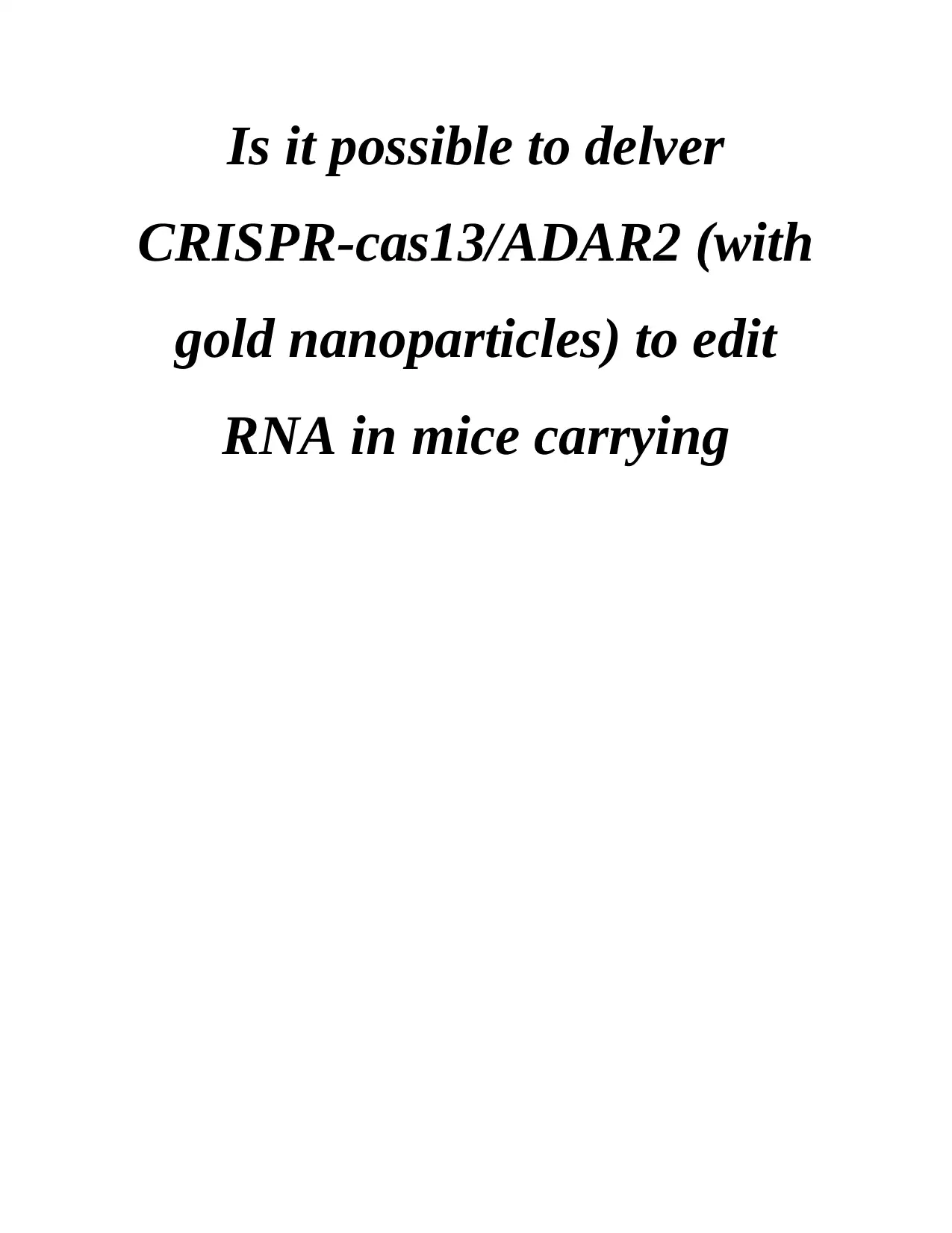
Is it possible to delver
CRISPR-cas13/ADAR2 (with
gold nanoparticles) to edit
RNA in mice carrying
CRISPR-cas13/ADAR2 (with
gold nanoparticles) to edit
RNA in mice carrying
Secure Best Marks with AI Grader
Need help grading? Try our AI Grader for instant feedback on your assignments.

Table of Contents
TITLE..............................................................................................................................................1
INTRODUCTION ..........................................................................................................................1
Overview of Research.................................................................................................................1
Rationale of Research.................................................................................................................2
Aim..............................................................................................................................................2
Objectives....................................................................................................................................2
Research Questions.....................................................................................................................2
Methodology...............................................................................................................................3
LITERATURE REVIEW................................................................................................................3
Human disease models which are created in mice......................................................................3
CRISPR cas 13 target RNA and changes in protein...................................................................4
Create mice models with SHANK3 to check improvements......................................................6
RESEARCH METHODOLOGY.....................................................................................................7
ANALYSIS & REPORTING........................................................................................................13
ETHICAL CONCERN..................................................................................................................22
REFERENCES..............................................................................................................................26
APPENDIX....................................................................................................................................28
TITLE..............................................................................................................................................1
INTRODUCTION ..........................................................................................................................1
Overview of Research.................................................................................................................1
Rationale of Research.................................................................................................................2
Aim..............................................................................................................................................2
Objectives....................................................................................................................................2
Research Questions.....................................................................................................................2
Methodology...............................................................................................................................3
LITERATURE REVIEW................................................................................................................3
Human disease models which are created in mice......................................................................3
CRISPR cas 13 target RNA and changes in protein...................................................................4
Create mice models with SHANK3 to check improvements......................................................6
RESEARCH METHODOLOGY.....................................................................................................7
ANALYSIS & REPORTING........................................................................................................13
ETHICAL CONCERN..................................................................................................................22
REFERENCES..............................................................................................................................26
APPENDIX....................................................................................................................................28
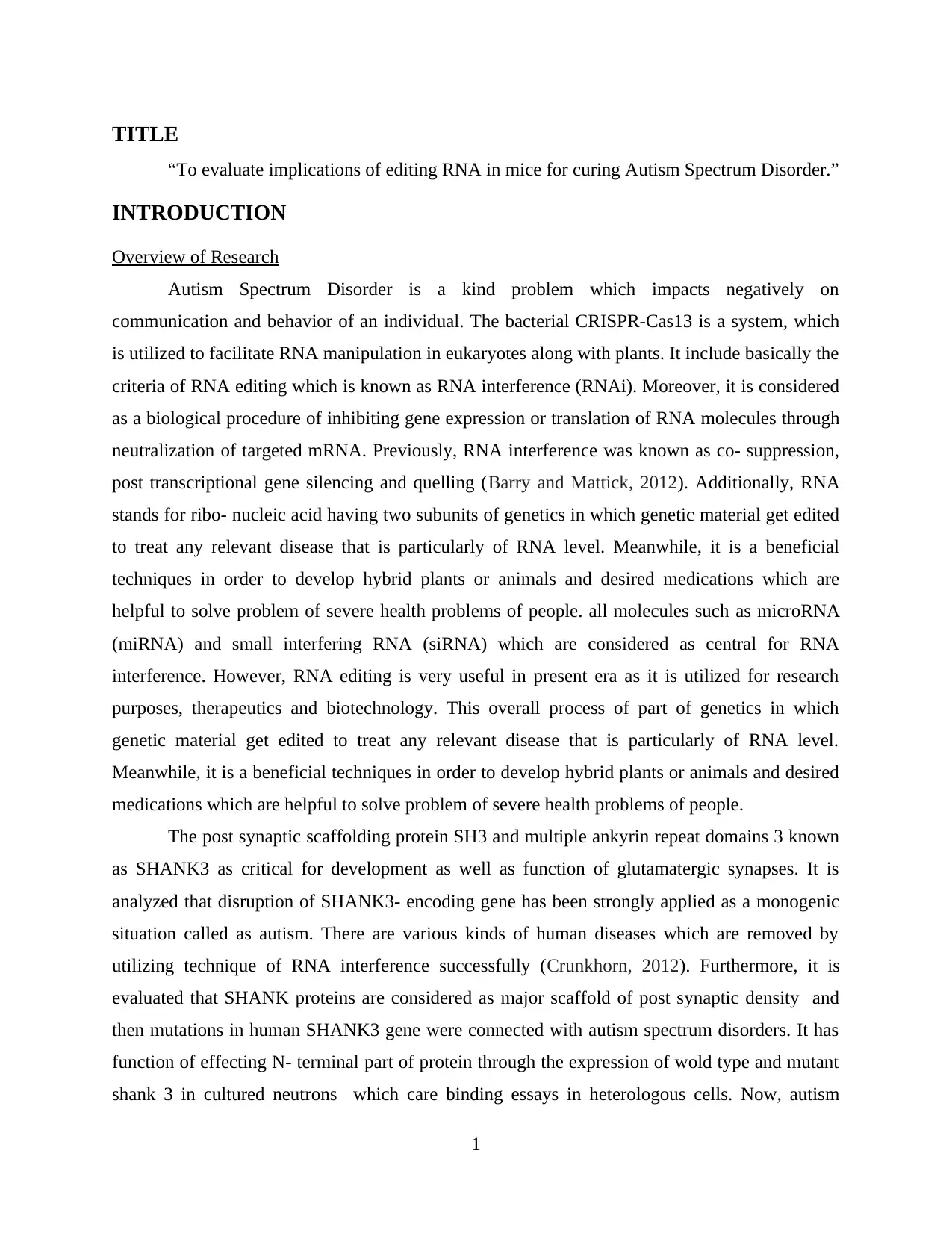
TITLE
“To evaluate implications of editing RNA in mice for curing Autism Spectrum Disorder.”
INTRODUCTION
Overview of Research
Autism Spectrum Disorder is a kind problem which impacts negatively on
communication and behavior of an individual. The bacterial CRISPR-Cas13 is a system, which
is utilized to facilitate RNA manipulation in eukaryotes along with plants. It include basically the
criteria of RNA editing which is known as RNA interference (RNAi). Moreover, it is considered
as a biological procedure of inhibiting gene expression or translation of RNA molecules through
neutralization of targeted mRNA. Previously, RNA interference was known as co- suppression,
post transcriptional gene silencing and quelling (Barry and Mattick, 2012). Additionally, RNA
stands for ribo- nucleic acid having two subunits of genetics in which genetic material get edited
to treat any relevant disease that is particularly of RNA level. Meanwhile, it is a beneficial
techniques in order to develop hybrid plants or animals and desired medications which are
helpful to solve problem of severe health problems of people. all molecules such as microRNA
(miRNA) and small interfering RNA (siRNA) which are considered as central for RNA
interference. However, RNA editing is very useful in present era as it is utilized for research
purposes, therapeutics and biotechnology. This overall process of part of genetics in which
genetic material get edited to treat any relevant disease that is particularly of RNA level.
Meanwhile, it is a beneficial techniques in order to develop hybrid plants or animals and desired
medications which are helpful to solve problem of severe health problems of people.
The post synaptic scaffolding protein SH3 and multiple ankyrin repeat domains 3 known
as SHANK3 as critical for development as well as function of glutamatergic synapses. It is
analyzed that disruption of SHANK3- encoding gene has been strongly applied as a monogenic
situation called as autism. There are various kinds of human diseases which are removed by
utilizing technique of RNA interference successfully (Crunkhorn, 2012). Furthermore, it is
evaluated that SHANK proteins are considered as major scaffold of post synaptic density and
then mutations in human SHANK3 gene were connected with autism spectrum disorders. It has
function of effecting N- terminal part of protein through the expression of wold type and mutant
shank 3 in cultured neutrons which care binding essays in heterologous cells. Now, autism
1
“To evaluate implications of editing RNA in mice for curing Autism Spectrum Disorder.”
INTRODUCTION
Overview of Research
Autism Spectrum Disorder is a kind problem which impacts negatively on
communication and behavior of an individual. The bacterial CRISPR-Cas13 is a system, which
is utilized to facilitate RNA manipulation in eukaryotes along with plants. It include basically the
criteria of RNA editing which is known as RNA interference (RNAi). Moreover, it is considered
as a biological procedure of inhibiting gene expression or translation of RNA molecules through
neutralization of targeted mRNA. Previously, RNA interference was known as co- suppression,
post transcriptional gene silencing and quelling (Barry and Mattick, 2012). Additionally, RNA
stands for ribo- nucleic acid having two subunits of genetics in which genetic material get edited
to treat any relevant disease that is particularly of RNA level. Meanwhile, it is a beneficial
techniques in order to develop hybrid plants or animals and desired medications which are
helpful to solve problem of severe health problems of people. all molecules such as microRNA
(miRNA) and small interfering RNA (siRNA) which are considered as central for RNA
interference. However, RNA editing is very useful in present era as it is utilized for research
purposes, therapeutics and biotechnology. This overall process of part of genetics in which
genetic material get edited to treat any relevant disease that is particularly of RNA level.
Meanwhile, it is a beneficial techniques in order to develop hybrid plants or animals and desired
medications which are helpful to solve problem of severe health problems of people.
The post synaptic scaffolding protein SH3 and multiple ankyrin repeat domains 3 known
as SHANK3 as critical for development as well as function of glutamatergic synapses. It is
analyzed that disruption of SHANK3- encoding gene has been strongly applied as a monogenic
situation called as autism. There are various kinds of human diseases which are removed by
utilizing technique of RNA interference successfully (Crunkhorn, 2012). Furthermore, it is
evaluated that SHANK proteins are considered as major scaffold of post synaptic density and
then mutations in human SHANK3 gene were connected with autism spectrum disorders. It has
function of effecting N- terminal part of protein through the expression of wold type and mutant
shank 3 in cultured neutrons which care binding essays in heterologous cells. Now, autism
1
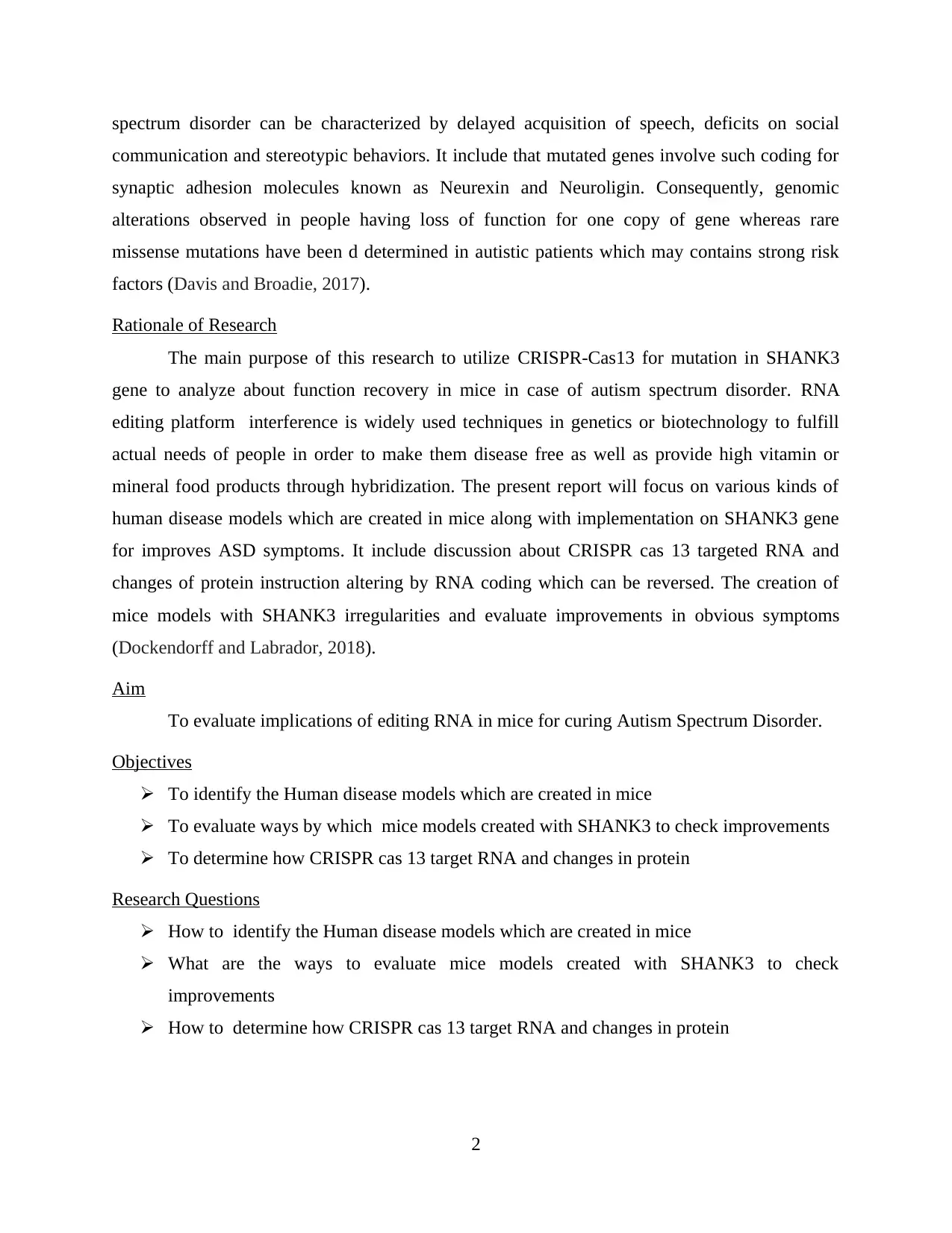
spectrum disorder can be characterized by delayed acquisition of speech, deficits on social
communication and stereotypic behaviors. It include that mutated genes involve such coding for
synaptic adhesion molecules known as Neurexin and Neuroligin. Consequently, genomic
alterations observed in people having loss of function for one copy of gene whereas rare
missense mutations have been d determined in autistic patients which may contains strong risk
factors (Davis and Broadie, 2017).
Rationale of Research
The main purpose of this research to utilize CRISPR-Cas13 for mutation in SHANK3
gene to analyze about function recovery in mice in case of autism spectrum disorder. RNA
editing platform interference is widely used techniques in genetics or biotechnology to fulfill
actual needs of people in order to make them disease free as well as provide high vitamin or
mineral food products through hybridization. The present report will focus on various kinds of
human disease models which are created in mice along with implementation on SHANK3 gene
for improves ASD symptoms. It include discussion about CRISPR cas 13 targeted RNA and
changes of protein instruction altering by RNA coding which can be reversed. The creation of
mice models with SHANK3 irregularities and evaluate improvements in obvious symptoms
(Dockendorff and Labrador, 2018).
Aim
To evaluate implications of editing RNA in mice for curing Autism Spectrum Disorder.
Objectives
To identify the Human disease models which are created in mice
To evaluate ways by which mice models created with SHANK3 to check improvements
To determine how CRISPR cas 13 target RNA and changes in protein
Research Questions
How to identify the Human disease models which are created in mice
What are the ways to evaluate mice models created with SHANK3 to check
improvements
How to determine how CRISPR cas 13 target RNA and changes in protein
2
communication and stereotypic behaviors. It include that mutated genes involve such coding for
synaptic adhesion molecules known as Neurexin and Neuroligin. Consequently, genomic
alterations observed in people having loss of function for one copy of gene whereas rare
missense mutations have been d determined in autistic patients which may contains strong risk
factors (Davis and Broadie, 2017).
Rationale of Research
The main purpose of this research to utilize CRISPR-Cas13 for mutation in SHANK3
gene to analyze about function recovery in mice in case of autism spectrum disorder. RNA
editing platform interference is widely used techniques in genetics or biotechnology to fulfill
actual needs of people in order to make them disease free as well as provide high vitamin or
mineral food products through hybridization. The present report will focus on various kinds of
human disease models which are created in mice along with implementation on SHANK3 gene
for improves ASD symptoms. It include discussion about CRISPR cas 13 targeted RNA and
changes of protein instruction altering by RNA coding which can be reversed. The creation of
mice models with SHANK3 irregularities and evaluate improvements in obvious symptoms
(Dockendorff and Labrador, 2018).
Aim
To evaluate implications of editing RNA in mice for curing Autism Spectrum Disorder.
Objectives
To identify the Human disease models which are created in mice
To evaluate ways by which mice models created with SHANK3 to check improvements
To determine how CRISPR cas 13 target RNA and changes in protein
Research Questions
How to identify the Human disease models which are created in mice
What are the ways to evaluate mice models created with SHANK3 to check
improvements
How to determine how CRISPR cas 13 target RNA and changes in protein
2
Secure Best Marks with AI Grader
Need help grading? Try our AI Grader for instant feedback on your assignments.
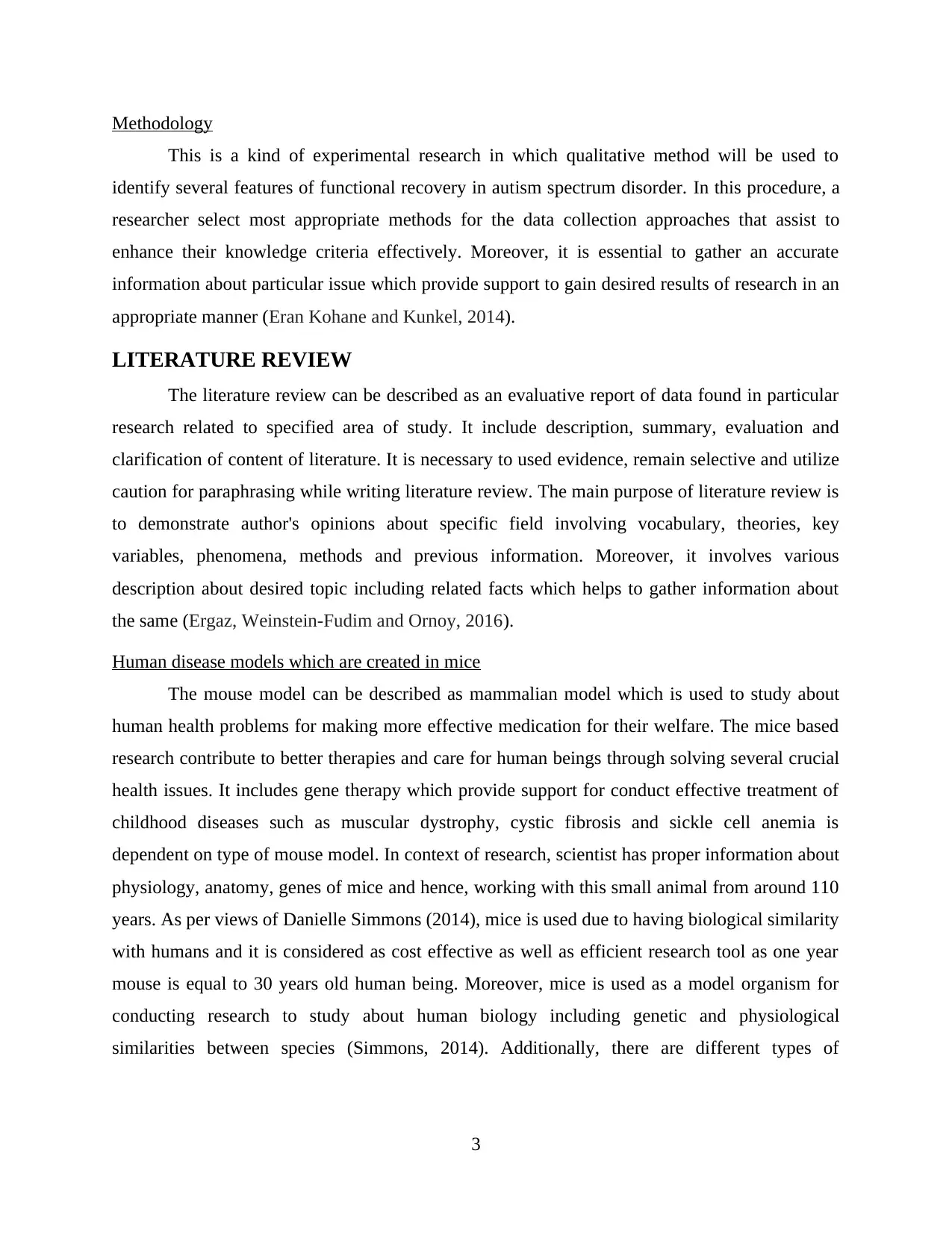
Methodology
This is a kind of experimental research in which qualitative method will be used to
identify several features of functional recovery in autism spectrum disorder. In this procedure, a
researcher select most appropriate methods for the data collection approaches that assist to
enhance their knowledge criteria effectively. Moreover, it is essential to gather an accurate
information about particular issue which provide support to gain desired results of research in an
appropriate manner (Eran Kohane and Kunkel, 2014).
LITERATURE REVIEW
The literature review can be described as an evaluative report of data found in particular
research related to specified area of study. It include description, summary, evaluation and
clarification of content of literature. It is necessary to used evidence, remain selective and utilize
caution for paraphrasing while writing literature review. The main purpose of literature review is
to demonstrate author's opinions about specific field involving vocabulary, theories, key
variables, phenomena, methods and previous information. Moreover, it involves various
description about desired topic including related facts which helps to gather information about
the same (Ergaz, Weinstein-Fudim and Ornoy, 2016).
Human disease models which are created in mice
The mouse model can be described as mammalian model which is used to study about
human health problems for making more effective medication for their welfare. The mice based
research contribute to better therapies and care for human beings through solving several crucial
health issues. It includes gene therapy which provide support for conduct effective treatment of
childhood diseases such as muscular dystrophy, cystic fibrosis and sickle cell anemia is
dependent on type of mouse model. In context of research, scientist has proper information about
physiology, anatomy, genes of mice and hence, working with this small animal from around 110
years. As per views of Danielle Simmons (2014), mice is used due to having biological similarity
with humans and it is considered as cost effective as well as efficient research tool as one year
mouse is equal to 30 years old human being. Moreover, mice is used as a model organism for
conducting research to study about human biology including genetic and physiological
similarities between species (Simmons, 2014). Additionally, there are different types of
3
This is a kind of experimental research in which qualitative method will be used to
identify several features of functional recovery in autism spectrum disorder. In this procedure, a
researcher select most appropriate methods for the data collection approaches that assist to
enhance their knowledge criteria effectively. Moreover, it is essential to gather an accurate
information about particular issue which provide support to gain desired results of research in an
appropriate manner (Eran Kohane and Kunkel, 2014).
LITERATURE REVIEW
The literature review can be described as an evaluative report of data found in particular
research related to specified area of study. It include description, summary, evaluation and
clarification of content of literature. It is necessary to used evidence, remain selective and utilize
caution for paraphrasing while writing literature review. The main purpose of literature review is
to demonstrate author's opinions about specific field involving vocabulary, theories, key
variables, phenomena, methods and previous information. Moreover, it involves various
description about desired topic including related facts which helps to gather information about
the same (Ergaz, Weinstein-Fudim and Ornoy, 2016).
Human disease models which are created in mice
The mouse model can be described as mammalian model which is used to study about
human health problems for making more effective medication for their welfare. The mice based
research contribute to better therapies and care for human beings through solving several crucial
health issues. It includes gene therapy which provide support for conduct effective treatment of
childhood diseases such as muscular dystrophy, cystic fibrosis and sickle cell anemia is
dependent on type of mouse model. In context of research, scientist has proper information about
physiology, anatomy, genes of mice and hence, working with this small animal from around 110
years. As per views of Danielle Simmons (2014), mice is used due to having biological similarity
with humans and it is considered as cost effective as well as efficient research tool as one year
mouse is equal to 30 years old human being. Moreover, mice is used as a model organism for
conducting research to study about human biology including genetic and physiological
similarities between species (Simmons, 2014). Additionally, there are different types of
3
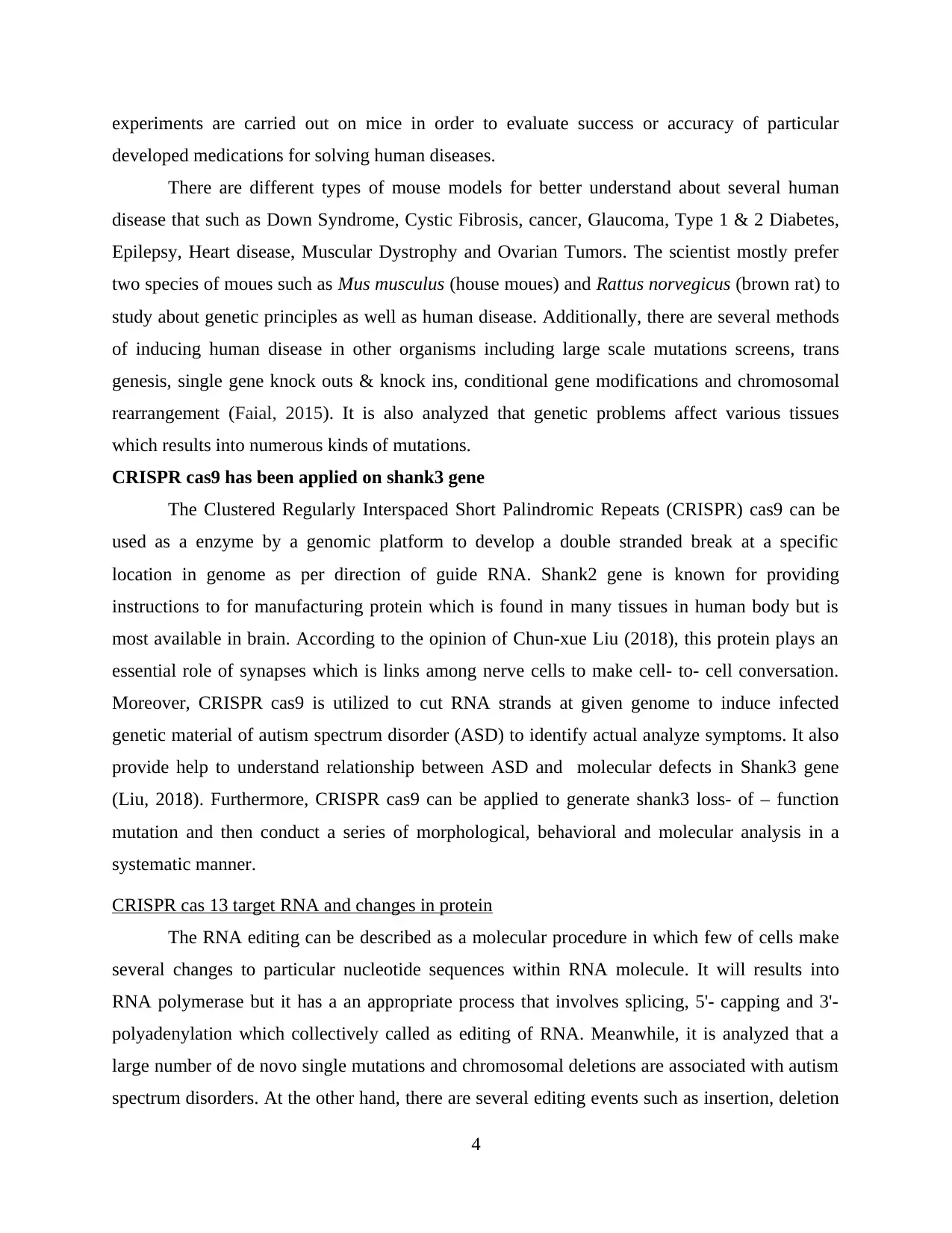
experiments are carried out on mice in order to evaluate success or accuracy of particular
developed medications for solving human diseases.
There are different types of mouse models for better understand about several human
disease that such as Down Syndrome, Cystic Fibrosis, cancer, Glaucoma, Type 1 & 2 Diabetes,
Epilepsy, Heart disease, Muscular Dystrophy and Ovarian Tumors. The scientist mostly prefer
two species of moues such as Mus musculus (house moues) and Rattus norvegicus (brown rat) to
study about genetic principles as well as human disease. Additionally, there are several methods
of inducing human disease in other organisms including large scale mutations screens, trans
genesis, single gene knock outs & knock ins, conditional gene modifications and chromosomal
rearrangement (Faial, 2015). It is also analyzed that genetic problems affect various tissues
which results into numerous kinds of mutations.
CRISPR cas9 has been applied on shank3 gene
The Clustered Regularly Interspaced Short Palindromic Repeats (CRISPR) cas9 can be
used as a enzyme by a genomic platform to develop a double stranded break at a specific
location in genome as per direction of guide RNA. Shank2 gene is known for providing
instructions to for manufacturing protein which is found in many tissues in human body but is
most available in brain. According to the opinion of Chun-xue Liu (2018), this protein plays an
essential role of synapses which is links among nerve cells to make cell- to- cell conversation.
Moreover, CRISPR cas9 is utilized to cut RNA strands at given genome to induce infected
genetic material of autism spectrum disorder (ASD) to identify actual analyze symptoms. It also
provide help to understand relationship between ASD and molecular defects in Shank3 gene
(Liu, 2018). Furthermore, CRISPR cas9 can be applied to generate shank3 loss- of – function
mutation and then conduct a series of morphological, behavioral and molecular analysis in a
systematic manner.
CRISPR cas 13 target RNA and changes in protein
The RNA editing can be described as a molecular procedure in which few of cells make
several changes to particular nucleotide sequences within RNA molecule. It will results into
RNA polymerase but it has a an appropriate process that involves splicing, 5'- capping and 3'-
polyadenylation which collectively called as editing of RNA. Meanwhile, it is analyzed that a
large number of de novo single mutations and chromosomal deletions are associated with autism
spectrum disorders. At the other hand, there are several editing events such as insertion, deletion
4
developed medications for solving human diseases.
There are different types of mouse models for better understand about several human
disease that such as Down Syndrome, Cystic Fibrosis, cancer, Glaucoma, Type 1 & 2 Diabetes,
Epilepsy, Heart disease, Muscular Dystrophy and Ovarian Tumors. The scientist mostly prefer
two species of moues such as Mus musculus (house moues) and Rattus norvegicus (brown rat) to
study about genetic principles as well as human disease. Additionally, there are several methods
of inducing human disease in other organisms including large scale mutations screens, trans
genesis, single gene knock outs & knock ins, conditional gene modifications and chromosomal
rearrangement (Faial, 2015). It is also analyzed that genetic problems affect various tissues
which results into numerous kinds of mutations.
CRISPR cas9 has been applied on shank3 gene
The Clustered Regularly Interspaced Short Palindromic Repeats (CRISPR) cas9 can be
used as a enzyme by a genomic platform to develop a double stranded break at a specific
location in genome as per direction of guide RNA. Shank2 gene is known for providing
instructions to for manufacturing protein which is found in many tissues in human body but is
most available in brain. According to the opinion of Chun-xue Liu (2018), this protein plays an
essential role of synapses which is links among nerve cells to make cell- to- cell conversation.
Moreover, CRISPR cas9 is utilized to cut RNA strands at given genome to induce infected
genetic material of autism spectrum disorder (ASD) to identify actual analyze symptoms. It also
provide help to understand relationship between ASD and molecular defects in Shank3 gene
(Liu, 2018). Furthermore, CRISPR cas9 can be applied to generate shank3 loss- of – function
mutation and then conduct a series of morphological, behavioral and molecular analysis in a
systematic manner.
CRISPR cas 13 target RNA and changes in protein
The RNA editing can be described as a molecular procedure in which few of cells make
several changes to particular nucleotide sequences within RNA molecule. It will results into
RNA polymerase but it has a an appropriate process that involves splicing, 5'- capping and 3'-
polyadenylation which collectively called as editing of RNA. Meanwhile, it is analyzed that a
large number of de novo single mutations and chromosomal deletions are associated with autism
spectrum disorders. At the other hand, there are several editing events such as insertion, deletion
4
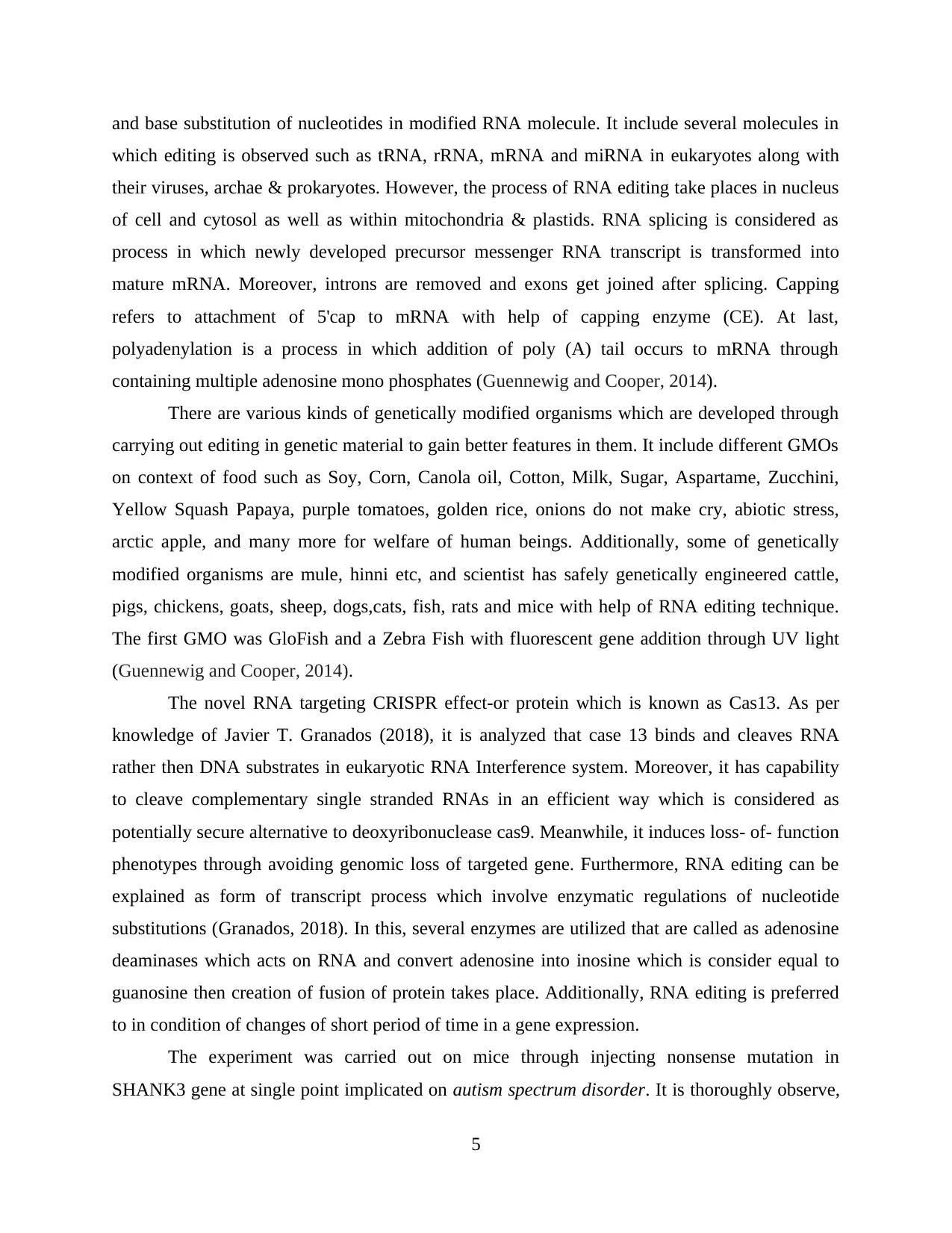
and base substitution of nucleotides in modified RNA molecule. It include several molecules in
which editing is observed such as tRNA, rRNA, mRNA and miRNA in eukaryotes along with
their viruses, archae & prokaryotes. However, the process of RNA editing take places in nucleus
of cell and cytosol as well as within mitochondria & plastids. RNA splicing is considered as
process in which newly developed precursor messenger RNA transcript is transformed into
mature mRNA. Moreover, introns are removed and exons get joined after splicing. Capping
refers to attachment of 5'cap to mRNA with help of capping enzyme (CE). At last,
polyadenylation is a process in which addition of poly (A) tail occurs to mRNA through
containing multiple adenosine mono phosphates (Guennewig and Cooper, 2014).
There are various kinds of genetically modified organisms which are developed through
carrying out editing in genetic material to gain better features in them. It include different GMOs
on context of food such as Soy, Corn, Canola oil, Cotton, Milk, Sugar, Aspartame, Zucchini,
Yellow Squash Papaya, purple tomatoes, golden rice, onions do not make cry, abiotic stress,
arctic apple, and many more for welfare of human beings. Additionally, some of genetically
modified organisms are mule, hinni etc, and scientist has safely genetically engineered cattle,
pigs, chickens, goats, sheep, dogs,cats, fish, rats and mice with help of RNA editing technique.
The first GMO was GloFish and a Zebra Fish with fluorescent gene addition through UV light
(Guennewig and Cooper, 2014).
The novel RNA targeting CRISPR effect-or protein which is known as Cas13. As per
knowledge of Javier T. Granados (2018), it is analyzed that case 13 binds and cleaves RNA
rather then DNA substrates in eukaryotic RNA Interference system. Moreover, it has capability
to cleave complementary single stranded RNAs in an efficient way which is considered as
potentially secure alternative to deoxyribonuclease cas9. Meanwhile, it induces loss- of- function
phenotypes through avoiding genomic loss of targeted gene. Furthermore, RNA editing can be
explained as form of transcript process which involve enzymatic regulations of nucleotide
substitutions (Granados, 2018). In this, several enzymes are utilized that are called as adenosine
deaminases which acts on RNA and convert adenosine into inosine which is consider equal to
guanosine then creation of fusion of protein takes place. Additionally, RNA editing is preferred
to in condition of changes of short period of time in a gene expression.
The experiment was carried out on mice through injecting nonsense mutation in
SHANK3 gene at single point implicated on autism spectrum disorder. It is thoroughly observe,
5
which editing is observed such as tRNA, rRNA, mRNA and miRNA in eukaryotes along with
their viruses, archae & prokaryotes. However, the process of RNA editing take places in nucleus
of cell and cytosol as well as within mitochondria & plastids. RNA splicing is considered as
process in which newly developed precursor messenger RNA transcript is transformed into
mature mRNA. Moreover, introns are removed and exons get joined after splicing. Capping
refers to attachment of 5'cap to mRNA with help of capping enzyme (CE). At last,
polyadenylation is a process in which addition of poly (A) tail occurs to mRNA through
containing multiple adenosine mono phosphates (Guennewig and Cooper, 2014).
There are various kinds of genetically modified organisms which are developed through
carrying out editing in genetic material to gain better features in them. It include different GMOs
on context of food such as Soy, Corn, Canola oil, Cotton, Milk, Sugar, Aspartame, Zucchini,
Yellow Squash Papaya, purple tomatoes, golden rice, onions do not make cry, abiotic stress,
arctic apple, and many more for welfare of human beings. Additionally, some of genetically
modified organisms are mule, hinni etc, and scientist has safely genetically engineered cattle,
pigs, chickens, goats, sheep, dogs,cats, fish, rats and mice with help of RNA editing technique.
The first GMO was GloFish and a Zebra Fish with fluorescent gene addition through UV light
(Guennewig and Cooper, 2014).
The novel RNA targeting CRISPR effect-or protein which is known as Cas13. As per
knowledge of Javier T. Granados (2018), it is analyzed that case 13 binds and cleaves RNA
rather then DNA substrates in eukaryotic RNA Interference system. Moreover, it has capability
to cleave complementary single stranded RNAs in an efficient way which is considered as
potentially secure alternative to deoxyribonuclease cas9. Meanwhile, it induces loss- of- function
phenotypes through avoiding genomic loss of targeted gene. Furthermore, RNA editing can be
explained as form of transcript process which involve enzymatic regulations of nucleotide
substitutions (Granados, 2018). In this, several enzymes are utilized that are called as adenosine
deaminases which acts on RNA and convert adenosine into inosine which is consider equal to
guanosine then creation of fusion of protein takes place. Additionally, RNA editing is preferred
to in condition of changes of short period of time in a gene expression.
The experiment was carried out on mice through injecting nonsense mutation in
SHANK3 gene at single point implicated on autism spectrum disorder. It is thoroughly observe,
5
Paraphrase This Document
Need a fresh take? Get an instant paraphrase of this document with our AI Paraphraser
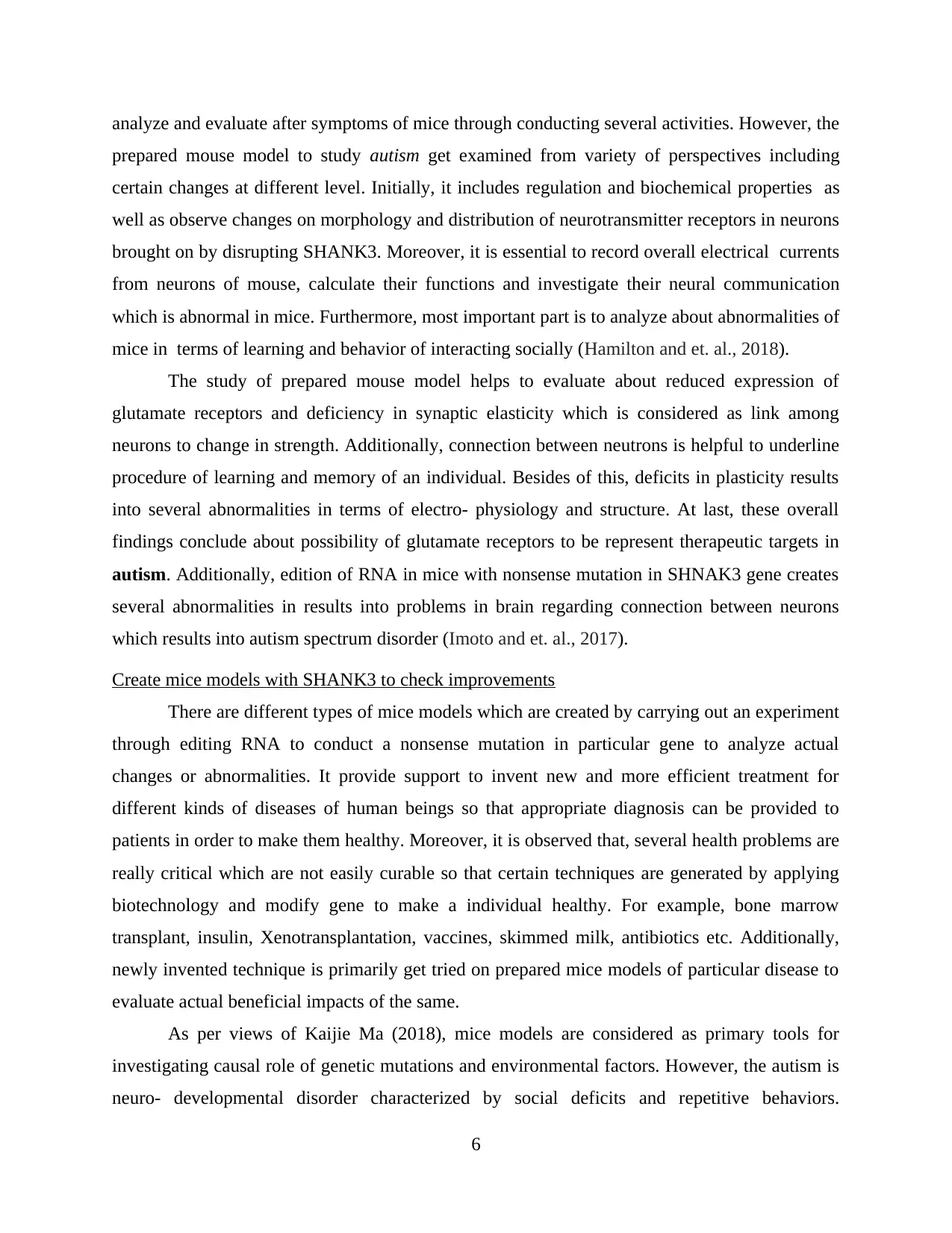
analyze and evaluate after symptoms of mice through conducting several activities. However, the
prepared mouse model to study autism get examined from variety of perspectives including
certain changes at different level. Initially, it includes regulation and biochemical properties as
well as observe changes on morphology and distribution of neurotransmitter receptors in neurons
brought on by disrupting SHANK3. Moreover, it is essential to record overall electrical currents
from neurons of mouse, calculate their functions and investigate their neural communication
which is abnormal in mice. Furthermore, most important part is to analyze about abnormalities of
mice in terms of learning and behavior of interacting socially (Hamilton and et. al., 2018).
The study of prepared mouse model helps to evaluate about reduced expression of
glutamate receptors and deficiency in synaptic elasticity which is considered as link among
neurons to change in strength. Additionally, connection between neutrons is helpful to underline
procedure of learning and memory of an individual. Besides of this, deficits in plasticity results
into several abnormalities in terms of electro- physiology and structure. At last, these overall
findings conclude about possibility of glutamate receptors to be represent therapeutic targets in
autism. Additionally, edition of RNA in mice with nonsense mutation in SHNAK3 gene creates
several abnormalities in results into problems in brain regarding connection between neurons
which results into autism spectrum disorder (Imoto and et. al., 2017).
Create mice models with SHANK3 to check improvements
There are different types of mice models which are created by carrying out an experiment
through editing RNA to conduct a nonsense mutation in particular gene to analyze actual
changes or abnormalities. It provide support to invent new and more efficient treatment for
different kinds of diseases of human beings so that appropriate diagnosis can be provided to
patients in order to make them healthy. Moreover, it is observed that, several health problems are
really critical which are not easily curable so that certain techniques are generated by applying
biotechnology and modify gene to make a individual healthy. For example, bone marrow
transplant, insulin, Xenotransplantation, vaccines, skimmed milk, antibiotics etc. Additionally,
newly invented technique is primarily get tried on prepared mice models of particular disease to
evaluate actual beneficial impacts of the same.
As per views of Kaijie Ma (2018), mice models are considered as primary tools for
investigating causal role of genetic mutations and environmental factors. However, the autism is
neuro- developmental disorder characterized by social deficits and repetitive behaviors.
6
prepared mouse model to study autism get examined from variety of perspectives including
certain changes at different level. Initially, it includes regulation and biochemical properties as
well as observe changes on morphology and distribution of neurotransmitter receptors in neurons
brought on by disrupting SHANK3. Moreover, it is essential to record overall electrical currents
from neurons of mouse, calculate their functions and investigate their neural communication
which is abnormal in mice. Furthermore, most important part is to analyze about abnormalities of
mice in terms of learning and behavior of interacting socially (Hamilton and et. al., 2018).
The study of prepared mouse model helps to evaluate about reduced expression of
glutamate receptors and deficiency in synaptic elasticity which is considered as link among
neurons to change in strength. Additionally, connection between neutrons is helpful to underline
procedure of learning and memory of an individual. Besides of this, deficits in plasticity results
into several abnormalities in terms of electro- physiology and structure. At last, these overall
findings conclude about possibility of glutamate receptors to be represent therapeutic targets in
autism. Additionally, edition of RNA in mice with nonsense mutation in SHNAK3 gene creates
several abnormalities in results into problems in brain regarding connection between neurons
which results into autism spectrum disorder (Imoto and et. al., 2017).
Create mice models with SHANK3 to check improvements
There are different types of mice models which are created by carrying out an experiment
through editing RNA to conduct a nonsense mutation in particular gene to analyze actual
changes or abnormalities. It provide support to invent new and more efficient treatment for
different kinds of diseases of human beings so that appropriate diagnosis can be provided to
patients in order to make them healthy. Moreover, it is observed that, several health problems are
really critical which are not easily curable so that certain techniques are generated by applying
biotechnology and modify gene to make a individual healthy. For example, bone marrow
transplant, insulin, Xenotransplantation, vaccines, skimmed milk, antibiotics etc. Additionally,
newly invented technique is primarily get tried on prepared mice models of particular disease to
evaluate actual beneficial impacts of the same.
As per views of Kaijie Ma (2018), mice models are considered as primary tools for
investigating causal role of genetic mutations and environmental factors. However, the autism is
neuro- developmental disorder characterized by social deficits and repetitive behaviors.
6
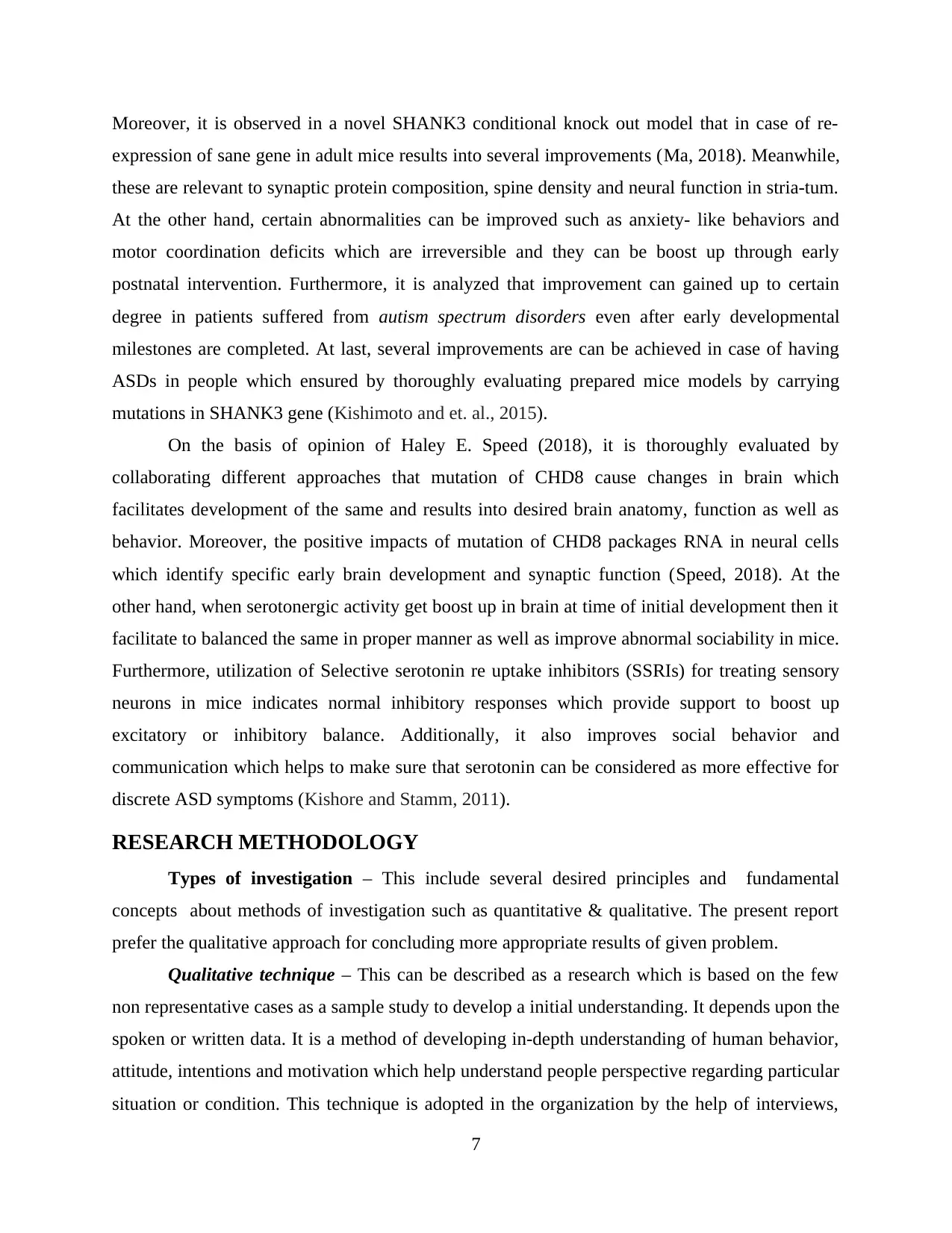
Moreover, it is observed in a novel SHANK3 conditional knock out model that in case of re-
expression of sane gene in adult mice results into several improvements (Ma, 2018). Meanwhile,
these are relevant to synaptic protein composition, spine density and neural function in stria-tum.
At the other hand, certain abnormalities can be improved such as anxiety- like behaviors and
motor coordination deficits which are irreversible and they can be boost up through early
postnatal intervention. Furthermore, it is analyzed that improvement can gained up to certain
degree in patients suffered from autism spectrum disorders even after early developmental
milestones are completed. At last, several improvements are can be achieved in case of having
ASDs in people which ensured by thoroughly evaluating prepared mice models by carrying
mutations in SHANK3 gene (Kishimoto and et. al., 2015).
On the basis of opinion of Haley E. Speed (2018), it is thoroughly evaluated by
collaborating different approaches that mutation of CHD8 cause changes in brain which
facilitates development of the same and results into desired brain anatomy, function as well as
behavior. Moreover, the positive impacts of mutation of CHD8 packages RNA in neural cells
which identify specific early brain development and synaptic function (Speed, 2018). At the
other hand, when serotonergic activity get boost up in brain at time of initial development then it
facilitate to balanced the same in proper manner as well as improve abnormal sociability in mice.
Furthermore, utilization of Selective serotonin re uptake inhibitors (SSRIs) for treating sensory
neurons in mice indicates normal inhibitory responses which provide support to boost up
excitatory or inhibitory balance. Additionally, it also improves social behavior and
communication which helps to make sure that serotonin can be considered as more effective for
discrete ASD symptoms (Kishore and Stamm, 2011).
RESEARCH METHODOLOGY
Types of investigation – This include several desired principles and fundamental
concepts about methods of investigation such as quantitative & qualitative. The present report
prefer the qualitative approach for concluding more appropriate results of given problem.
Qualitative technique – This can be described as a research which is based on the few
non representative cases as a sample study to develop a initial understanding. It depends upon the
spoken or written data. It is a method of developing in-depth understanding of human behavior,
attitude, intentions and motivation which help understand people perspective regarding particular
situation or condition. This technique is adopted in the organization by the help of interviews,
7
expression of sane gene in adult mice results into several improvements (Ma, 2018). Meanwhile,
these are relevant to synaptic protein composition, spine density and neural function in stria-tum.
At the other hand, certain abnormalities can be improved such as anxiety- like behaviors and
motor coordination deficits which are irreversible and they can be boost up through early
postnatal intervention. Furthermore, it is analyzed that improvement can gained up to certain
degree in patients suffered from autism spectrum disorders even after early developmental
milestones are completed. At last, several improvements are can be achieved in case of having
ASDs in people which ensured by thoroughly evaluating prepared mice models by carrying
mutations in SHANK3 gene (Kishimoto and et. al., 2015).
On the basis of opinion of Haley E. Speed (2018), it is thoroughly evaluated by
collaborating different approaches that mutation of CHD8 cause changes in brain which
facilitates development of the same and results into desired brain anatomy, function as well as
behavior. Moreover, the positive impacts of mutation of CHD8 packages RNA in neural cells
which identify specific early brain development and synaptic function (Speed, 2018). At the
other hand, when serotonergic activity get boost up in brain at time of initial development then it
facilitate to balanced the same in proper manner as well as improve abnormal sociability in mice.
Furthermore, utilization of Selective serotonin re uptake inhibitors (SSRIs) for treating sensory
neurons in mice indicates normal inhibitory responses which provide support to boost up
excitatory or inhibitory balance. Additionally, it also improves social behavior and
communication which helps to make sure that serotonin can be considered as more effective for
discrete ASD symptoms (Kishore and Stamm, 2011).
RESEARCH METHODOLOGY
Types of investigation – This include several desired principles and fundamental
concepts about methods of investigation such as quantitative & qualitative. The present report
prefer the qualitative approach for concluding more appropriate results of given problem.
Qualitative technique – This can be described as a research which is based on the few
non representative cases as a sample study to develop a initial understanding. It depends upon the
spoken or written data. It is a method of developing in-depth understanding of human behavior,
attitude, intentions and motivation which help understand people perspective regarding particular
situation or condition. This technique is adopted in the organization by the help of interviews,
7
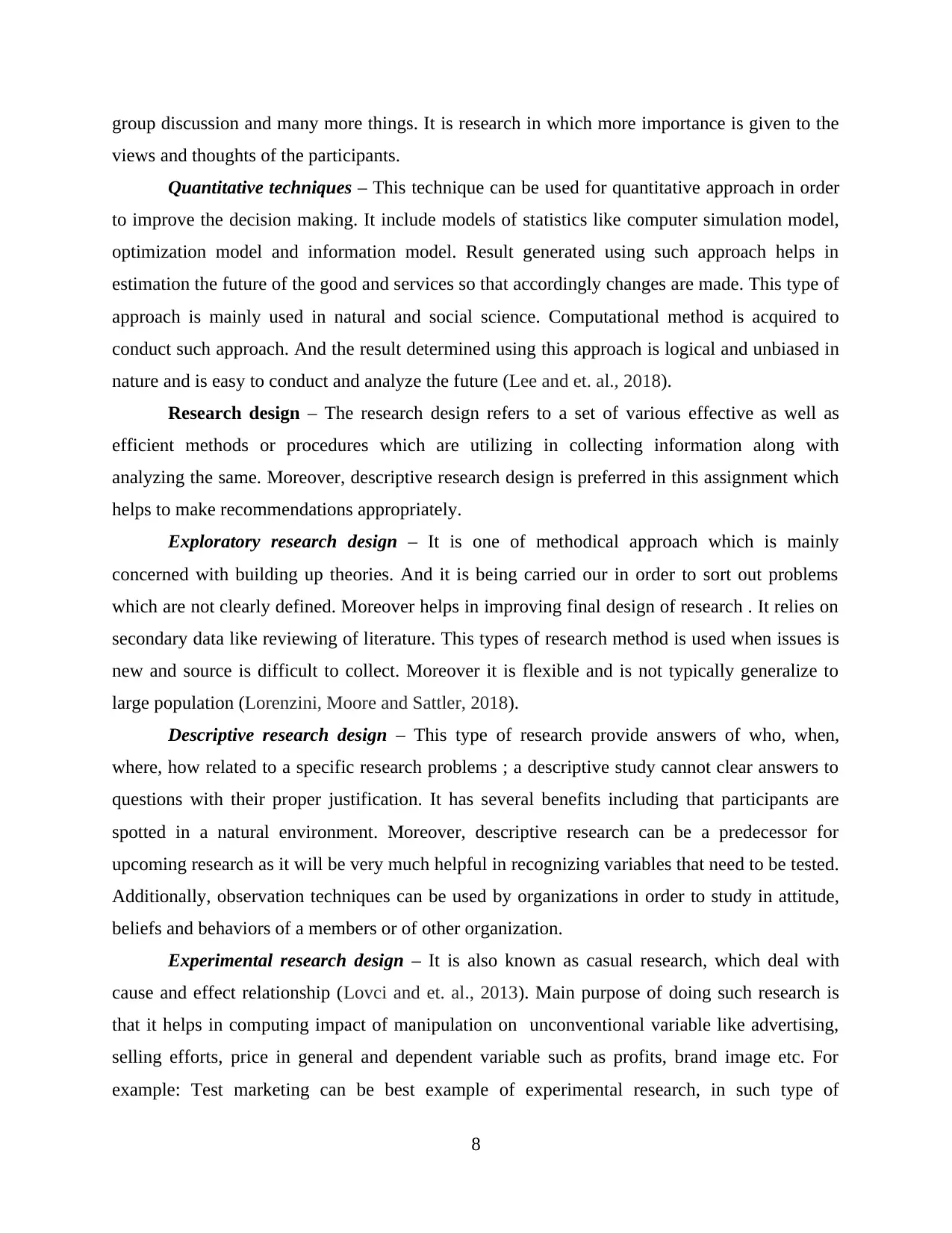
group discussion and many more things. It is research in which more importance is given to the
views and thoughts of the participants.
Quantitative techniques – This technique can be used for quantitative approach in order
to improve the decision making. It include models of statistics like computer simulation model,
optimization model and information model. Result generated using such approach helps in
estimation the future of the good and services so that accordingly changes are made. This type of
approach is mainly used in natural and social science. Computational method is acquired to
conduct such approach. And the result determined using this approach is logical and unbiased in
nature and is easy to conduct and analyze the future (Lee and et. al., 2018).
Research design – The research design refers to a set of various effective as well as
efficient methods or procedures which are utilizing in collecting information along with
analyzing the same. Moreover, descriptive research design is preferred in this assignment which
helps to make recommendations appropriately.
Exploratory research design – It is one of methodical approach which is mainly
concerned with building up theories. And it is being carried our in order to sort out problems
which are not clearly defined. Moreover helps in improving final design of research . It relies on
secondary data like reviewing of literature. This types of research method is used when issues is
new and source is difficult to collect. Moreover it is flexible and is not typically generalize to
large population (Lorenzini, Moore and Sattler, 2018).
Descriptive research design – This type of research provide answers of who, when,
where, how related to a specific research problems ; a descriptive study cannot clear answers to
questions with their proper justification. It has several benefits including that participants are
spotted in a natural environment. Moreover, descriptive research can be a predecessor for
upcoming research as it will be very much helpful in recognizing variables that need to be tested.
Additionally, observation techniques can be used by organizations in order to study in attitude,
beliefs and behaviors of a members or of other organization.
Experimental research design – It is also known as casual research, which deal with
cause and effect relationship (Lovci and et. al., 2013). Main purpose of doing such research is
that it helps in computing impact of manipulation on unconventional variable like advertising,
selling efforts, price in general and dependent variable such as profits, brand image etc. For
example: Test marketing can be best example of experimental research, in such type of
8
views and thoughts of the participants.
Quantitative techniques – This technique can be used for quantitative approach in order
to improve the decision making. It include models of statistics like computer simulation model,
optimization model and information model. Result generated using such approach helps in
estimation the future of the good and services so that accordingly changes are made. This type of
approach is mainly used in natural and social science. Computational method is acquired to
conduct such approach. And the result determined using this approach is logical and unbiased in
nature and is easy to conduct and analyze the future (Lee and et. al., 2018).
Research design – The research design refers to a set of various effective as well as
efficient methods or procedures which are utilizing in collecting information along with
analyzing the same. Moreover, descriptive research design is preferred in this assignment which
helps to make recommendations appropriately.
Exploratory research design – It is one of methodical approach which is mainly
concerned with building up theories. And it is being carried our in order to sort out problems
which are not clearly defined. Moreover helps in improving final design of research . It relies on
secondary data like reviewing of literature. This types of research method is used when issues is
new and source is difficult to collect. Moreover it is flexible and is not typically generalize to
large population (Lorenzini, Moore and Sattler, 2018).
Descriptive research design – This type of research provide answers of who, when,
where, how related to a specific research problems ; a descriptive study cannot clear answers to
questions with their proper justification. It has several benefits including that participants are
spotted in a natural environment. Moreover, descriptive research can be a predecessor for
upcoming research as it will be very much helpful in recognizing variables that need to be tested.
Additionally, observation techniques can be used by organizations in order to study in attitude,
beliefs and behaviors of a members or of other organization.
Experimental research design – It is also known as casual research, which deal with
cause and effect relationship (Lovci and et. al., 2013). Main purpose of doing such research is
that it helps in computing impact of manipulation on unconventional variable like advertising,
selling efforts, price in general and dependent variable such as profits, brand image etc. For
example: Test marketing can be best example of experimental research, in such type of
8
Secure Best Marks with AI Grader
Need help grading? Try our AI Grader for instant feedback on your assignments.
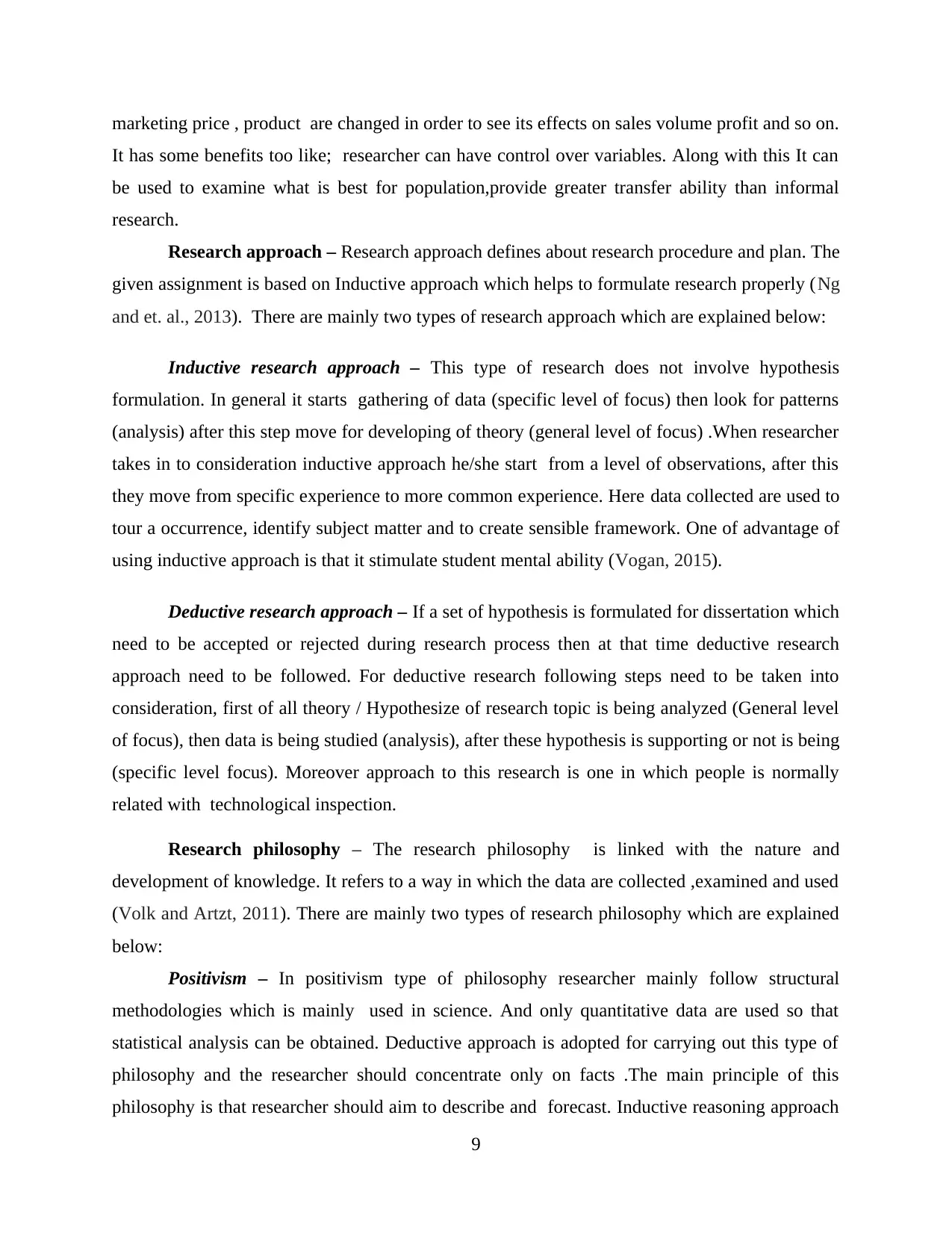
marketing price , product are changed in order to see its effects on sales volume profit and so on.
It has some benefits too like; researcher can have control over variables. Along with this It can
be used to examine what is best for population,provide greater transfer ability than informal
research.
Research approach – Research approach defines about research procedure and plan. The
given assignment is based on Inductive approach which helps to formulate research properly (Ng
and et. al., 2013). There are mainly two types of research approach which are explained below:
Inductive research approach – This type of research does not involve hypothesis
formulation. In general it starts gathering of data (specific level of focus) then look for patterns
(analysis) after this step move for developing of theory (general level of focus) .When researcher
takes in to consideration inductive approach he/she start from a level of observations, after this
they move from specific experience to more common experience. Here data collected are used to
tour a occurrence, identify subject matter and to create sensible framework. One of advantage of
using inductive approach is that it stimulate student mental ability (Vogan, 2015).
Deductive research approach – If a set of hypothesis is formulated for dissertation which
need to be accepted or rejected during research process then at that time deductive research
approach need to be followed. For deductive research following steps need to be taken into
consideration, first of all theory / Hypothesize of research topic is being analyzed (General level
of focus), then data is being studied (analysis), after these hypothesis is supporting or not is being
(specific level focus). Moreover approach to this research is one in which people is normally
related with technological inspection.
Research philosophy – The research philosophy is linked with the nature and
development of knowledge. It refers to a way in which the data are collected ,examined and used
(Volk and Artzt, 2011). There are mainly two types of research philosophy which are explained
below:
Positivism – In positivism type of philosophy researcher mainly follow structural
methodologies which is mainly used in science. And only quantitative data are used so that
statistical analysis can be obtained. Deductive approach is adopted for carrying out this type of
philosophy and the researcher should concentrate only on facts .The main principle of this
philosophy is that researcher should aim to describe and forecast. Inductive reasoning approach
9
It has some benefits too like; researcher can have control over variables. Along with this It can
be used to examine what is best for population,provide greater transfer ability than informal
research.
Research approach – Research approach defines about research procedure and plan. The
given assignment is based on Inductive approach which helps to formulate research properly (Ng
and et. al., 2013). There are mainly two types of research approach which are explained below:
Inductive research approach – This type of research does not involve hypothesis
formulation. In general it starts gathering of data (specific level of focus) then look for patterns
(analysis) after this step move for developing of theory (general level of focus) .When researcher
takes in to consideration inductive approach he/she start from a level of observations, after this
they move from specific experience to more common experience. Here data collected are used to
tour a occurrence, identify subject matter and to create sensible framework. One of advantage of
using inductive approach is that it stimulate student mental ability (Vogan, 2015).
Deductive research approach – If a set of hypothesis is formulated for dissertation which
need to be accepted or rejected during research process then at that time deductive research
approach need to be followed. For deductive research following steps need to be taken into
consideration, first of all theory / Hypothesize of research topic is being analyzed (General level
of focus), then data is being studied (analysis), after these hypothesis is supporting or not is being
(specific level focus). Moreover approach to this research is one in which people is normally
related with technological inspection.
Research philosophy – The research philosophy is linked with the nature and
development of knowledge. It refers to a way in which the data are collected ,examined and used
(Volk and Artzt, 2011). There are mainly two types of research philosophy which are explained
below:
Positivism – In positivism type of philosophy researcher mainly follow structural
methodologies which is mainly used in science. And only quantitative data are used so that
statistical analysis can be obtained. Deductive approach is adopted for carrying out this type of
philosophy and the researcher should concentrate only on facts .The main principle of this
philosophy is that researcher should aim to describe and forecast. Inductive reasoning approach
9
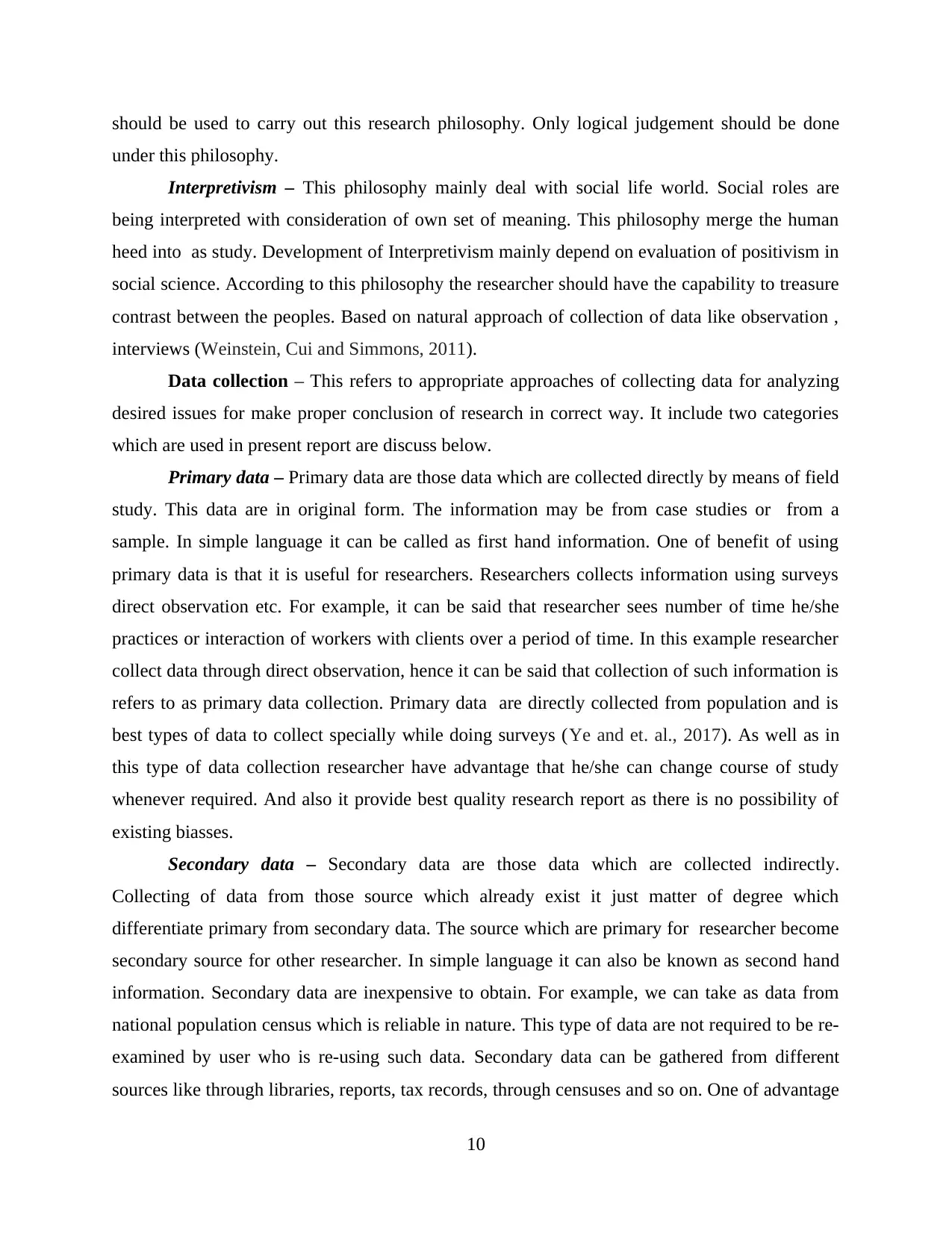
should be used to carry out this research philosophy. Only logical judgement should be done
under this philosophy.
Interpretivism – This philosophy mainly deal with social life world. Social roles are
being interpreted with consideration of own set of meaning. This philosophy merge the human
heed into as study. Development of Interpretivism mainly depend on evaluation of positivism in
social science. According to this philosophy the researcher should have the capability to treasure
contrast between the peoples. Based on natural approach of collection of data like observation ,
interviews (Weinstein, Cui and Simmons, 2011).
Data collection – This refers to appropriate approaches of collecting data for analyzing
desired issues for make proper conclusion of research in correct way. It include two categories
which are used in present report are discuss below.
Primary data – Primary data are those data which are collected directly by means of field
study. This data are in original form. The information may be from case studies or from a
sample. In simple language it can be called as first hand information. One of benefit of using
primary data is that it is useful for researchers. Researchers collects information using surveys
direct observation etc. For example, it can be said that researcher sees number of time he/she
practices or interaction of workers with clients over a period of time. In this example researcher
collect data through direct observation, hence it can be said that collection of such information is
refers to as primary data collection. Primary data are directly collected from population and is
best types of data to collect specially while doing surveys (Ye and et. al., 2017). As well as in
this type of data collection researcher have advantage that he/she can change course of study
whenever required. And also it provide best quality research report as there is no possibility of
existing biasses.
Secondary data – Secondary data are those data which are collected indirectly.
Collecting of data from those source which already exist it just matter of degree which
differentiate primary from secondary data. The source which are primary for researcher become
secondary source for other researcher. In simple language it can also be known as second hand
information. Secondary data are inexpensive to obtain. For example, we can take as data from
national population census which is reliable in nature. This type of data are not required to be re-
examined by user who is re-using such data. Secondary data can be gathered from different
sources like through libraries, reports, tax records, through censuses and so on. One of advantage
10
under this philosophy.
Interpretivism – This philosophy mainly deal with social life world. Social roles are
being interpreted with consideration of own set of meaning. This philosophy merge the human
heed into as study. Development of Interpretivism mainly depend on evaluation of positivism in
social science. According to this philosophy the researcher should have the capability to treasure
contrast between the peoples. Based on natural approach of collection of data like observation ,
interviews (Weinstein, Cui and Simmons, 2011).
Data collection – This refers to appropriate approaches of collecting data for analyzing
desired issues for make proper conclusion of research in correct way. It include two categories
which are used in present report are discuss below.
Primary data – Primary data are those data which are collected directly by means of field
study. This data are in original form. The information may be from case studies or from a
sample. In simple language it can be called as first hand information. One of benefit of using
primary data is that it is useful for researchers. Researchers collects information using surveys
direct observation etc. For example, it can be said that researcher sees number of time he/she
practices or interaction of workers with clients over a period of time. In this example researcher
collect data through direct observation, hence it can be said that collection of such information is
refers to as primary data collection. Primary data are directly collected from population and is
best types of data to collect specially while doing surveys (Ye and et. al., 2017). As well as in
this type of data collection researcher have advantage that he/she can change course of study
whenever required. And also it provide best quality research report as there is no possibility of
existing biasses.
Secondary data – Secondary data are those data which are collected indirectly.
Collecting of data from those source which already exist it just matter of degree which
differentiate primary from secondary data. The source which are primary for researcher become
secondary source for other researcher. In simple language it can also be known as second hand
information. Secondary data are inexpensive to obtain. For example, we can take as data from
national population census which is reliable in nature. This type of data are not required to be re-
examined by user who is re-using such data. Secondary data can be gathered from different
sources like through libraries, reports, tax records, through censuses and so on. One of advantage
10
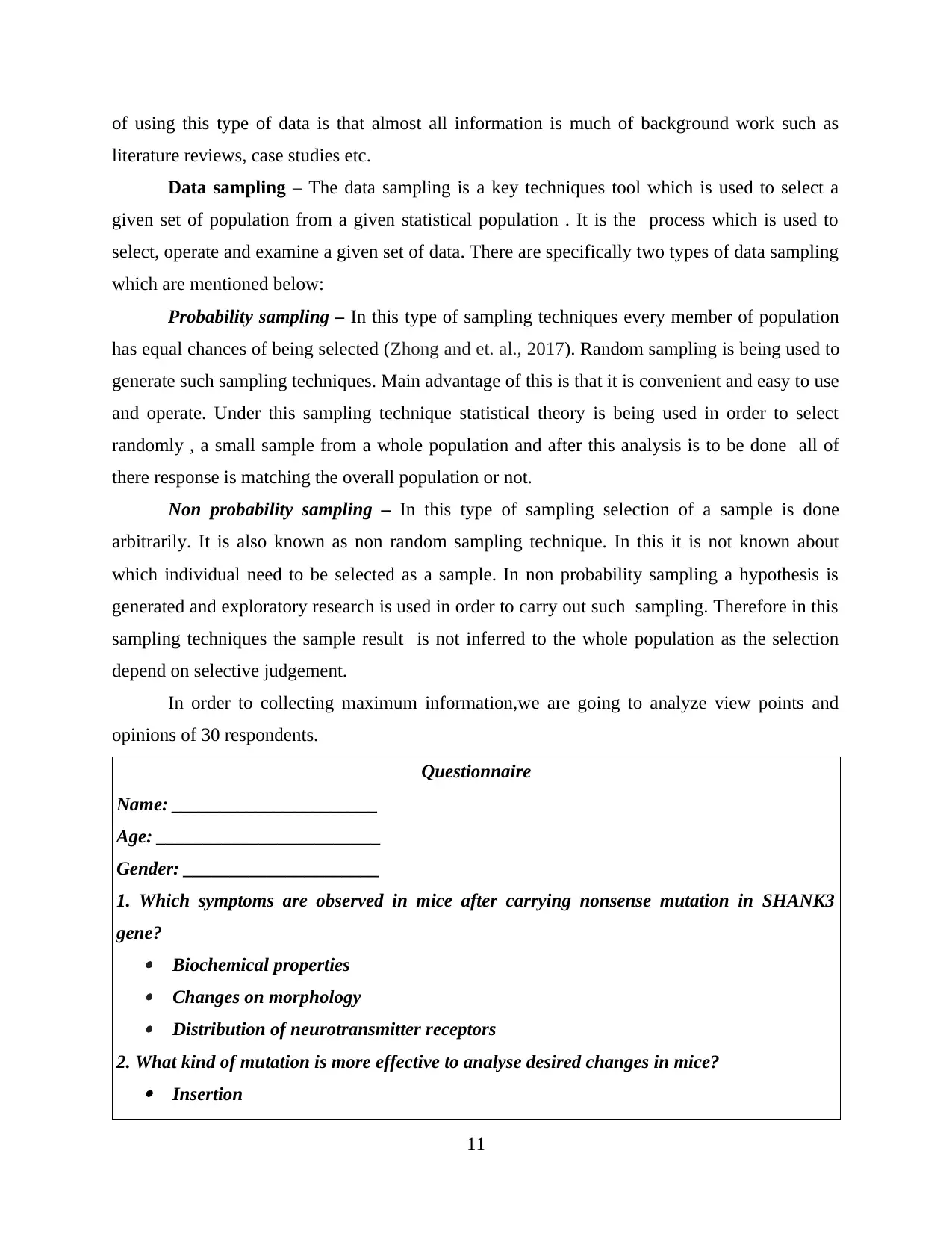
of using this type of data is that almost all information is much of background work such as
literature reviews, case studies etc.
Data sampling – The data sampling is a key techniques tool which is used to select a
given set of population from a given statistical population . It is the process which is used to
select, operate and examine a given set of data. There are specifically two types of data sampling
which are mentioned below:
Probability sampling – In this type of sampling techniques every member of population
has equal chances of being selected (Zhong and et. al., 2017). Random sampling is being used to
generate such sampling techniques. Main advantage of this is that it is convenient and easy to use
and operate. Under this sampling technique statistical theory is being used in order to select
randomly , a small sample from a whole population and after this analysis is to be done all of
there response is matching the overall population or not.
Non probability sampling – In this type of sampling selection of a sample is done
arbitrarily. It is also known as non random sampling technique. In this it is not known about
which individual need to be selected as a sample. In non probability sampling a hypothesis is
generated and exploratory research is used in order to carry out such sampling. Therefore in this
sampling techniques the sample result is not inferred to the whole population as the selection
depend on selective judgement.
In order to collecting maximum information,we are going to analyze view points and
opinions of 30 respondents.
Questionnaire
Name: ______________________
Age: ________________________
Gender: _____________________
1. Which symptoms are observed in mice after carrying nonsense mutation in SHANK3
gene? Biochemical properties Changes on morphology Distribution of neurotransmitter receptors
2. What kind of mutation is more effective to analyse desired changes in mice? Insertion
11
literature reviews, case studies etc.
Data sampling – The data sampling is a key techniques tool which is used to select a
given set of population from a given statistical population . It is the process which is used to
select, operate and examine a given set of data. There are specifically two types of data sampling
which are mentioned below:
Probability sampling – In this type of sampling techniques every member of population
has equal chances of being selected (Zhong and et. al., 2017). Random sampling is being used to
generate such sampling techniques. Main advantage of this is that it is convenient and easy to use
and operate. Under this sampling technique statistical theory is being used in order to select
randomly , a small sample from a whole population and after this analysis is to be done all of
there response is matching the overall population or not.
Non probability sampling – In this type of sampling selection of a sample is done
arbitrarily. It is also known as non random sampling technique. In this it is not known about
which individual need to be selected as a sample. In non probability sampling a hypothesis is
generated and exploratory research is used in order to carry out such sampling. Therefore in this
sampling techniques the sample result is not inferred to the whole population as the selection
depend on selective judgement.
In order to collecting maximum information,we are going to analyze view points and
opinions of 30 respondents.
Questionnaire
Name: ______________________
Age: ________________________
Gender: _____________________
1. Which symptoms are observed in mice after carrying nonsense mutation in SHANK3
gene? Biochemical properties Changes on morphology Distribution of neurotransmitter receptors
2. What kind of mutation is more effective to analyse desired changes in mice? Insertion
11
Paraphrase This Document
Need a fresh take? Get an instant paraphrase of this document with our AI Paraphraser
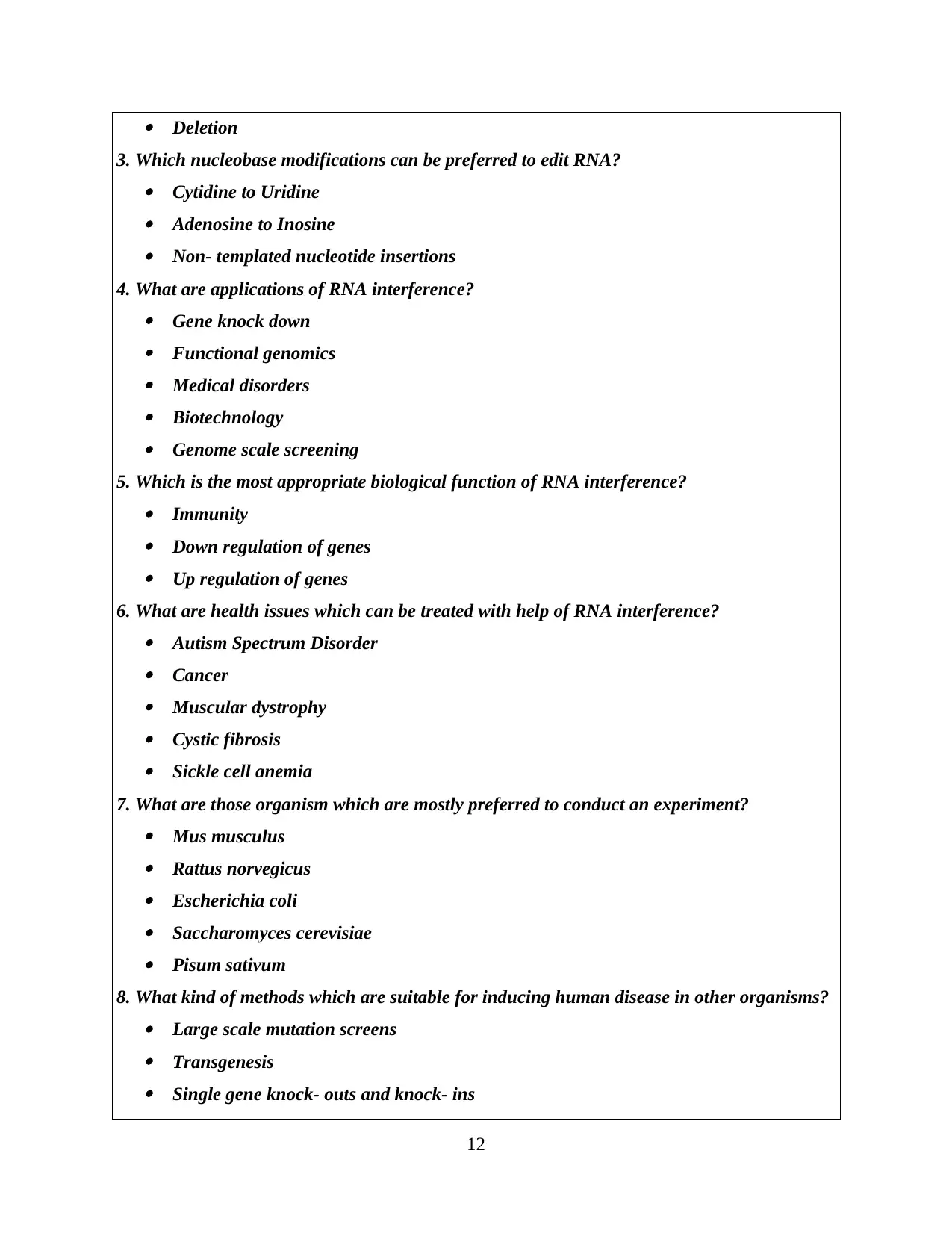
Deletion
3. Which nucleobase modifications can be preferred to edit RNA? Cytidine to Uridine Adenosine to Inosine Non- templated nucleotide insertions
4. What are applications of RNA interference? Gene knock down Functional genomics Medical disorders Biotechnology Genome scale screening
5. Which is the most appropriate biological function of RNA interference? Immunity Down regulation of genes Up regulation of genes
6. What are health issues which can be treated with help of RNA interference? Autism Spectrum Disorder Cancer Muscular dystrophy Cystic fibrosis Sickle cell anemia
7. What are those organism which are mostly preferred to conduct an experiment? Mus musculus Rattus norvegicus Escherichia coli Saccharomyces cerevisiae Pisum sativum
8. What kind of methods which are suitable for inducing human disease in other organisms? Large scale mutation screens Transgenesis Single gene knock- outs and knock- ins
12
3. Which nucleobase modifications can be preferred to edit RNA? Cytidine to Uridine Adenosine to Inosine Non- templated nucleotide insertions
4. What are applications of RNA interference? Gene knock down Functional genomics Medical disorders Biotechnology Genome scale screening
5. Which is the most appropriate biological function of RNA interference? Immunity Down regulation of genes Up regulation of genes
6. What are health issues which can be treated with help of RNA interference? Autism Spectrum Disorder Cancer Muscular dystrophy Cystic fibrosis Sickle cell anemia
7. What are those organism which are mostly preferred to conduct an experiment? Mus musculus Rattus norvegicus Escherichia coli Saccharomyces cerevisiae Pisum sativum
8. What kind of methods which are suitable for inducing human disease in other organisms? Large scale mutation screens Transgenesis Single gene knock- outs and knock- ins
12
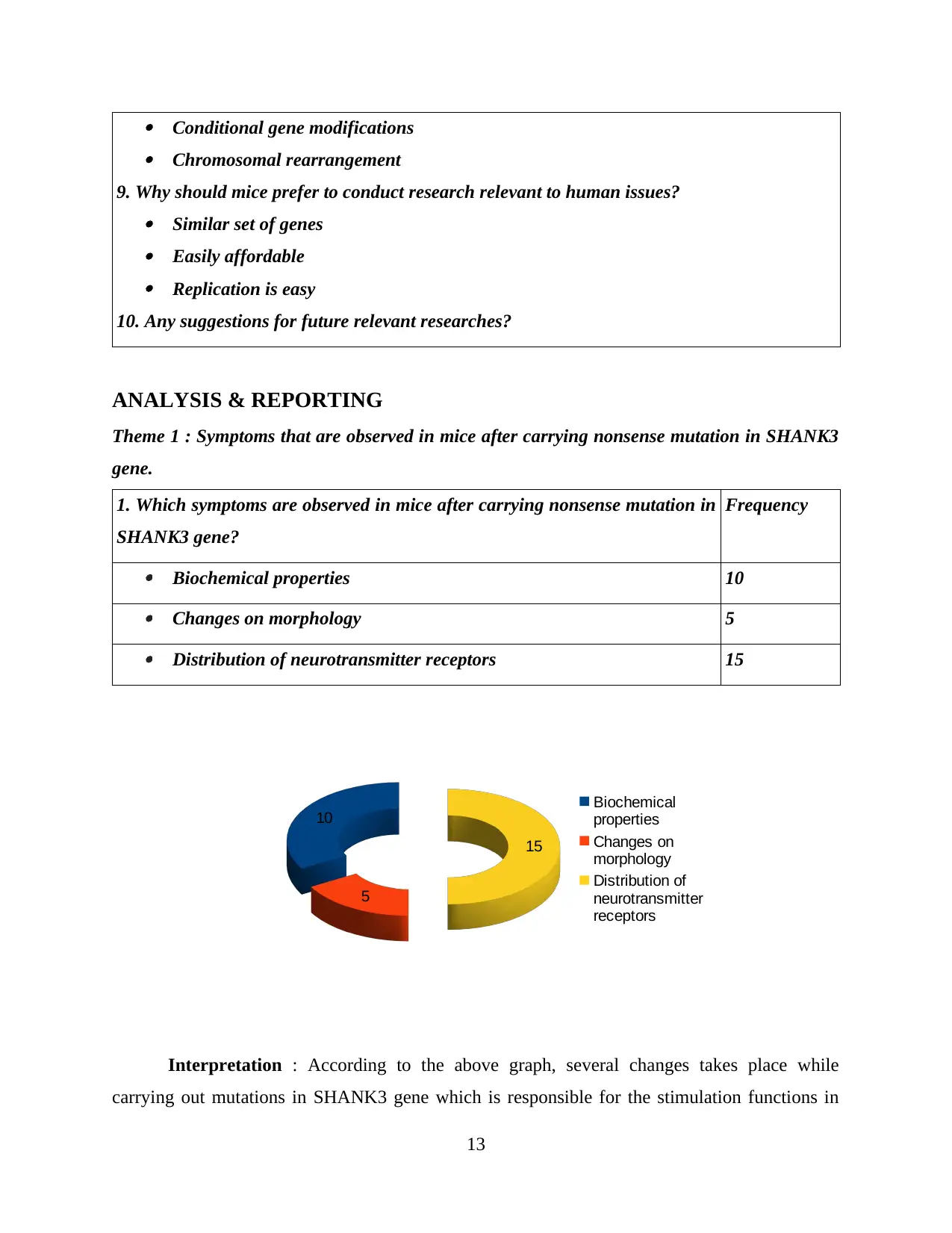
Conditional gene modifications Chromosomal rearrangement
9. Why should mice prefer to conduct research relevant to human issues? Similar set of genes Easily affordable Replication is easy
10. Any suggestions for future relevant researches?
ANALYSIS & REPORTING
Theme 1 : Symptoms that are observed in mice after carrying nonsense mutation in SHANK3
gene.
1. Which symptoms are observed in mice after carrying nonsense mutation in
SHANK3 gene?
Frequency
Biochemical properties 10 Changes on morphology 5 Distribution of neurotransmitter receptors 15
Interpretation : According to the above graph, several changes takes place while
carrying out mutations in SHANK3 gene which is responsible for the stimulation functions in
13
10
5
15
Biochemical
properties
Changes on
morphology
Distribution of
neurotransmitter
receptors
9. Why should mice prefer to conduct research relevant to human issues? Similar set of genes Easily affordable Replication is easy
10. Any suggestions for future relevant researches?
ANALYSIS & REPORTING
Theme 1 : Symptoms that are observed in mice after carrying nonsense mutation in SHANK3
gene.
1. Which symptoms are observed in mice after carrying nonsense mutation in
SHANK3 gene?
Frequency
Biochemical properties 10 Changes on morphology 5 Distribution of neurotransmitter receptors 15
Interpretation : According to the above graph, several changes takes place while
carrying out mutations in SHANK3 gene which is responsible for the stimulation functions in
13
10
5
15
Biochemical
properties
Changes on
morphology
Distribution of
neurotransmitter
receptors
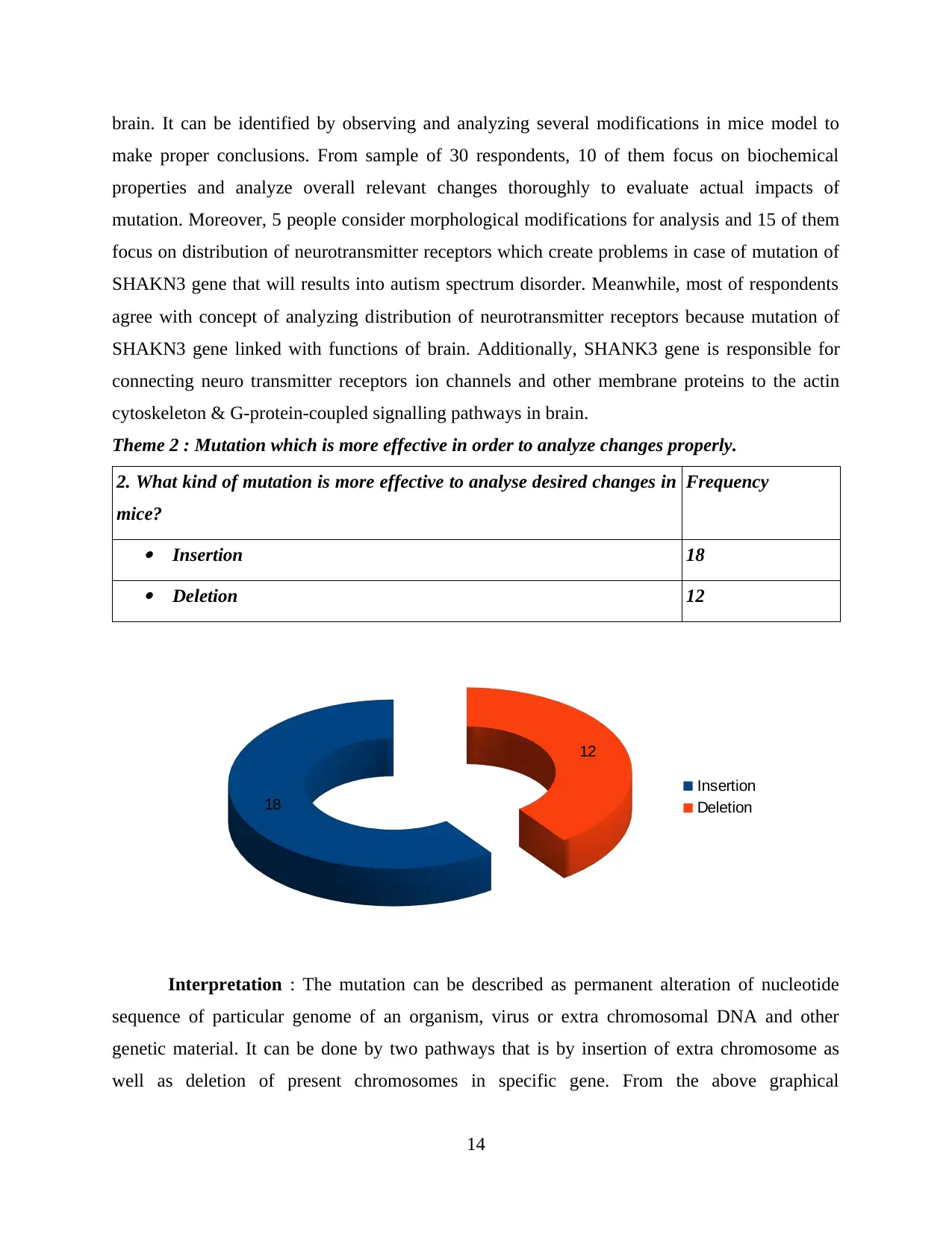
brain. It can be identified by observing and analyzing several modifications in mice model to
make proper conclusions. From sample of 30 respondents, 10 of them focus on biochemical
properties and analyze overall relevant changes thoroughly to evaluate actual impacts of
mutation. Moreover, 5 people consider morphological modifications for analysis and 15 of them
focus on distribution of neurotransmitter receptors which create problems in case of mutation of
SHAKN3 gene that will results into autism spectrum disorder. Meanwhile, most of respondents
agree with concept of analyzing distribution of neurotransmitter receptors because mutation of
SHAKN3 gene linked with functions of brain. Additionally, SHANK3 gene is responsible for
connecting neuro transmitter receptors ion channels and other membrane proteins to the actin
cytoskeleton & G-protein-coupled signalling pathways in brain.
Theme 2 : Mutation which is more effective in order to analyze changes properly.
2. What kind of mutation is more effective to analyse desired changes in
mice?
Frequency
Insertion 18 Deletion 12
Interpretation : The mutation can be described as permanent alteration of nucleotide
sequence of particular genome of an organism, virus or extra chromosomal DNA and other
genetic material. It can be done by two pathways that is by insertion of extra chromosome as
well as deletion of present chromosomes in specific gene. From the above graphical
14
18
12
Insertion
Deletion
make proper conclusions. From sample of 30 respondents, 10 of them focus on biochemical
properties and analyze overall relevant changes thoroughly to evaluate actual impacts of
mutation. Moreover, 5 people consider morphological modifications for analysis and 15 of them
focus on distribution of neurotransmitter receptors which create problems in case of mutation of
SHAKN3 gene that will results into autism spectrum disorder. Meanwhile, most of respondents
agree with concept of analyzing distribution of neurotransmitter receptors because mutation of
SHAKN3 gene linked with functions of brain. Additionally, SHANK3 gene is responsible for
connecting neuro transmitter receptors ion channels and other membrane proteins to the actin
cytoskeleton & G-protein-coupled signalling pathways in brain.
Theme 2 : Mutation which is more effective in order to analyze changes properly.
2. What kind of mutation is more effective to analyse desired changes in
mice?
Frequency
Insertion 18 Deletion 12
Interpretation : The mutation can be described as permanent alteration of nucleotide
sequence of particular genome of an organism, virus or extra chromosomal DNA and other
genetic material. It can be done by two pathways that is by insertion of extra chromosome as
well as deletion of present chromosomes in specific gene. From the above graphical
14
18
12
Insertion
Deletion
Secure Best Marks with AI Grader
Need help grading? Try our AI Grader for instant feedback on your assignments.
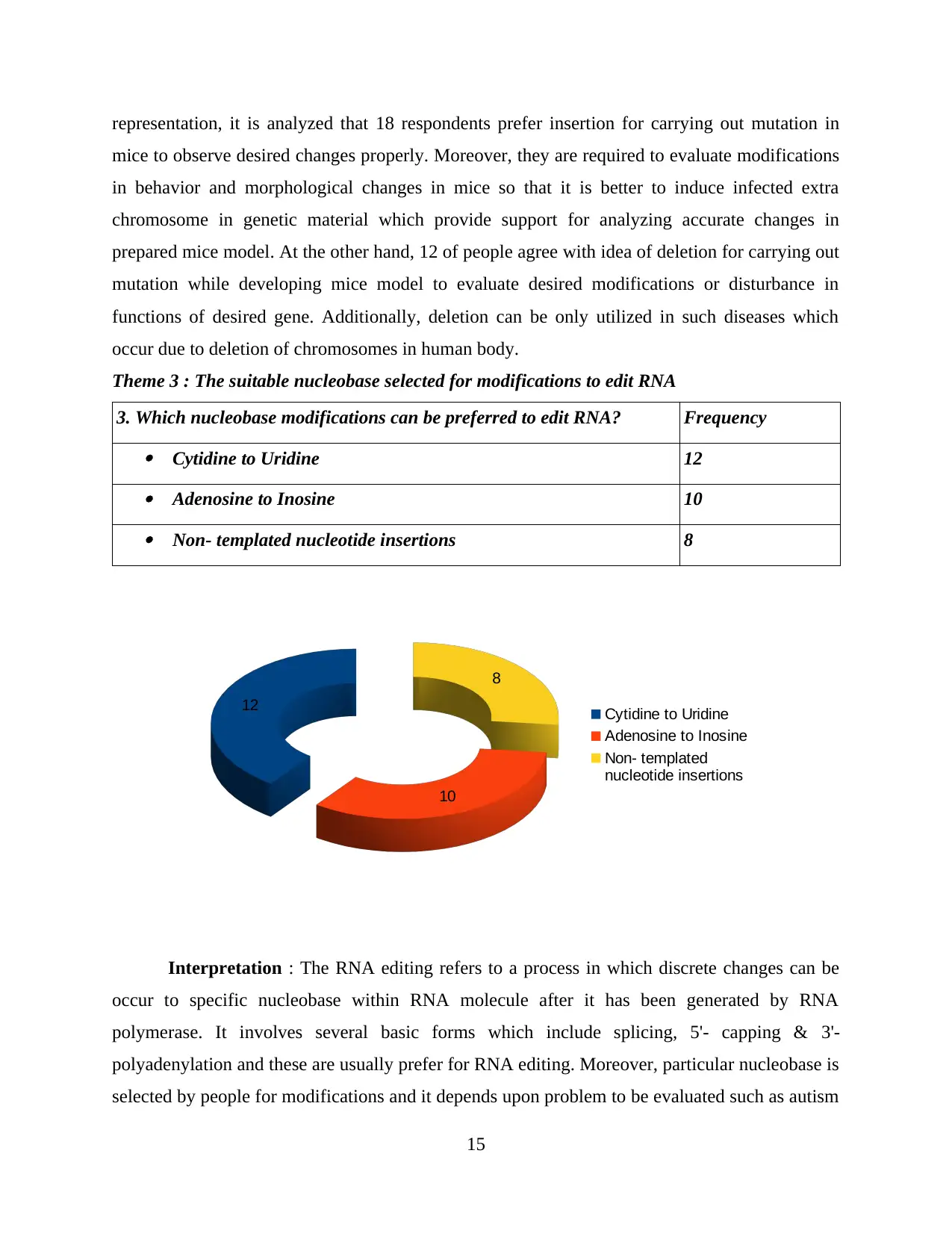
representation, it is analyzed that 18 respondents prefer insertion for carrying out mutation in
mice to observe desired changes properly. Moreover, they are required to evaluate modifications
in behavior and morphological changes in mice so that it is better to induce infected extra
chromosome in genetic material which provide support for analyzing accurate changes in
prepared mice model. At the other hand, 12 of people agree with idea of deletion for carrying out
mutation while developing mice model to evaluate desired modifications or disturbance in
functions of desired gene. Additionally, deletion can be only utilized in such diseases which
occur due to deletion of chromosomes in human body.
Theme 3 : The suitable nucleobase selected for modifications to edit RNA
3. Which nucleobase modifications can be preferred to edit RNA? Frequency Cytidine to Uridine 12 Adenosine to Inosine 10 Non- templated nucleotide insertions 8
Interpretation : The RNA editing refers to a process in which discrete changes can be
occur to specific nucleobase within RNA molecule after it has been generated by RNA
polymerase. It involves several basic forms which include splicing, 5'- capping & 3'-
polyadenylation and these are usually prefer for RNA editing. Moreover, particular nucleobase is
selected by people for modifications and it depends upon problem to be evaluated such as autism
15
12
10
8
Cytidine to Uridine
Adenosine to Inosine
Non- templated
nucleotide insertions
mice to observe desired changes properly. Moreover, they are required to evaluate modifications
in behavior and morphological changes in mice so that it is better to induce infected extra
chromosome in genetic material which provide support for analyzing accurate changes in
prepared mice model. At the other hand, 12 of people agree with idea of deletion for carrying out
mutation while developing mice model to evaluate desired modifications or disturbance in
functions of desired gene. Additionally, deletion can be only utilized in such diseases which
occur due to deletion of chromosomes in human body.
Theme 3 : The suitable nucleobase selected for modifications to edit RNA
3. Which nucleobase modifications can be preferred to edit RNA? Frequency Cytidine to Uridine 12 Adenosine to Inosine 10 Non- templated nucleotide insertions 8
Interpretation : The RNA editing refers to a process in which discrete changes can be
occur to specific nucleobase within RNA molecule after it has been generated by RNA
polymerase. It involves several basic forms which include splicing, 5'- capping & 3'-
polyadenylation and these are usually prefer for RNA editing. Moreover, particular nucleobase is
selected by people for modifications and it depends upon problem to be evaluated such as autism
15
12
10
8
Cytidine to Uridine
Adenosine to Inosine
Non- templated
nucleotide insertions
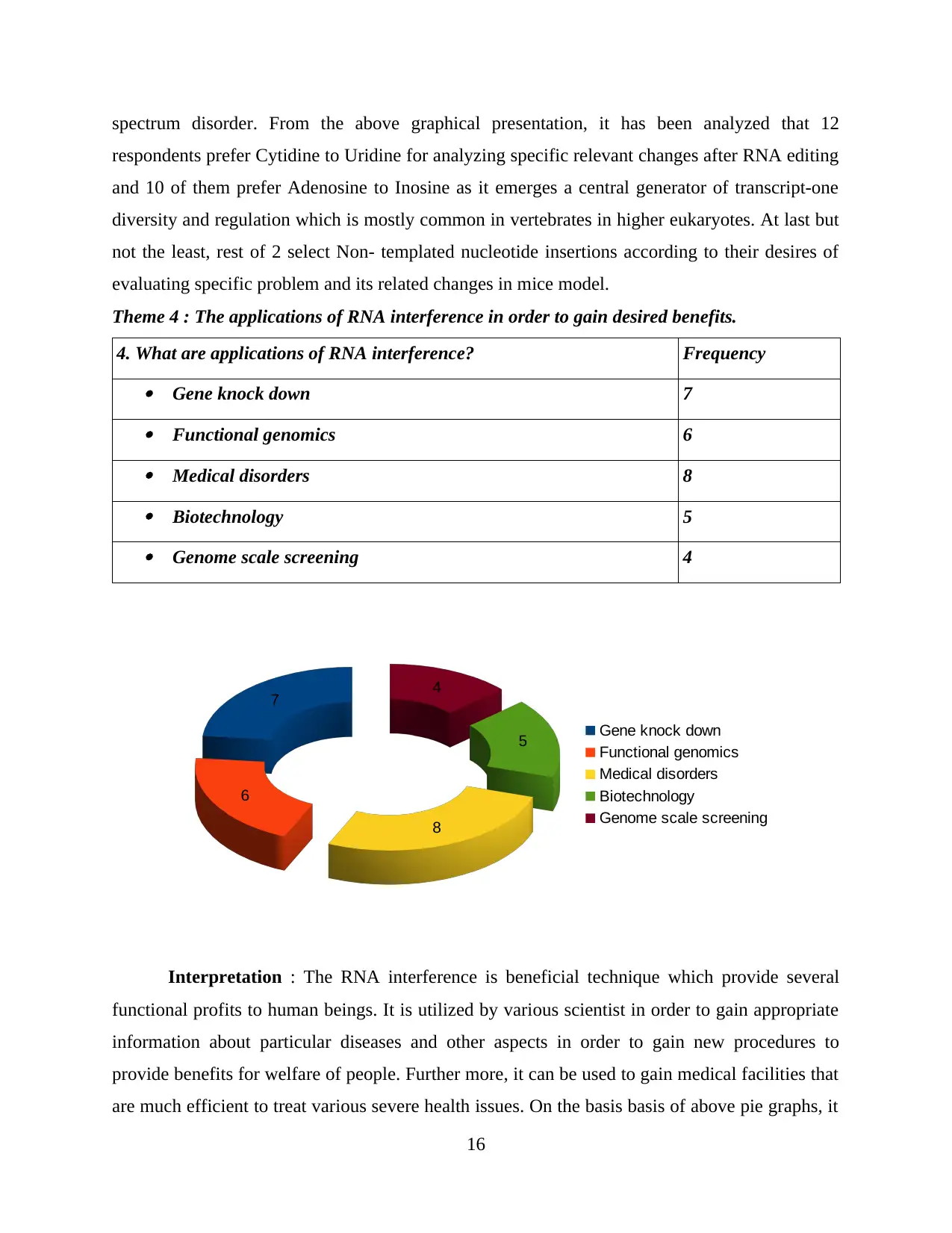
spectrum disorder. From the above graphical presentation, it has been analyzed that 12
respondents prefer Cytidine to Uridine for analyzing specific relevant changes after RNA editing
and 10 of them prefer Adenosine to Inosine as it emerges a central generator of transcript-one
diversity and regulation which is mostly common in vertebrates in higher eukaryotes. At last but
not the least, rest of 2 select Non- templated nucleotide insertions according to their desires of
evaluating specific problem and its related changes in mice model.
Theme 4 : The applications of RNA interference in order to gain desired benefits.
4. What are applications of RNA interference? Frequency Gene knock down 7 Functional genomics 6 Medical disorders 8 Biotechnology 5 Genome scale screening 4
Interpretation : The RNA interference is beneficial technique which provide several
functional profits to human beings. It is utilized by various scientist in order to gain appropriate
information about particular diseases and other aspects in order to gain new procedures to
provide benefits for welfare of people. Further more, it can be used to gain medical facilities that
are much efficient to treat various severe health issues. On the basis basis of above pie graphs, it
16
7
6
8
5
4
Gene knock down
Functional genomics
Medical disorders
Biotechnology
Genome scale screening
respondents prefer Cytidine to Uridine for analyzing specific relevant changes after RNA editing
and 10 of them prefer Adenosine to Inosine as it emerges a central generator of transcript-one
diversity and regulation which is mostly common in vertebrates in higher eukaryotes. At last but
not the least, rest of 2 select Non- templated nucleotide insertions according to their desires of
evaluating specific problem and its related changes in mice model.
Theme 4 : The applications of RNA interference in order to gain desired benefits.
4. What are applications of RNA interference? Frequency Gene knock down 7 Functional genomics 6 Medical disorders 8 Biotechnology 5 Genome scale screening 4
Interpretation : The RNA interference is beneficial technique which provide several
functional profits to human beings. It is utilized by various scientist in order to gain appropriate
information about particular diseases and other aspects in order to gain new procedures to
provide benefits for welfare of people. Further more, it can be used to gain medical facilities that
are much efficient to treat various severe health issues. On the basis basis of above pie graphs, it
16
7
6
8
5
4
Gene knock down
Functional genomics
Medical disorders
Biotechnology
Genome scale screening
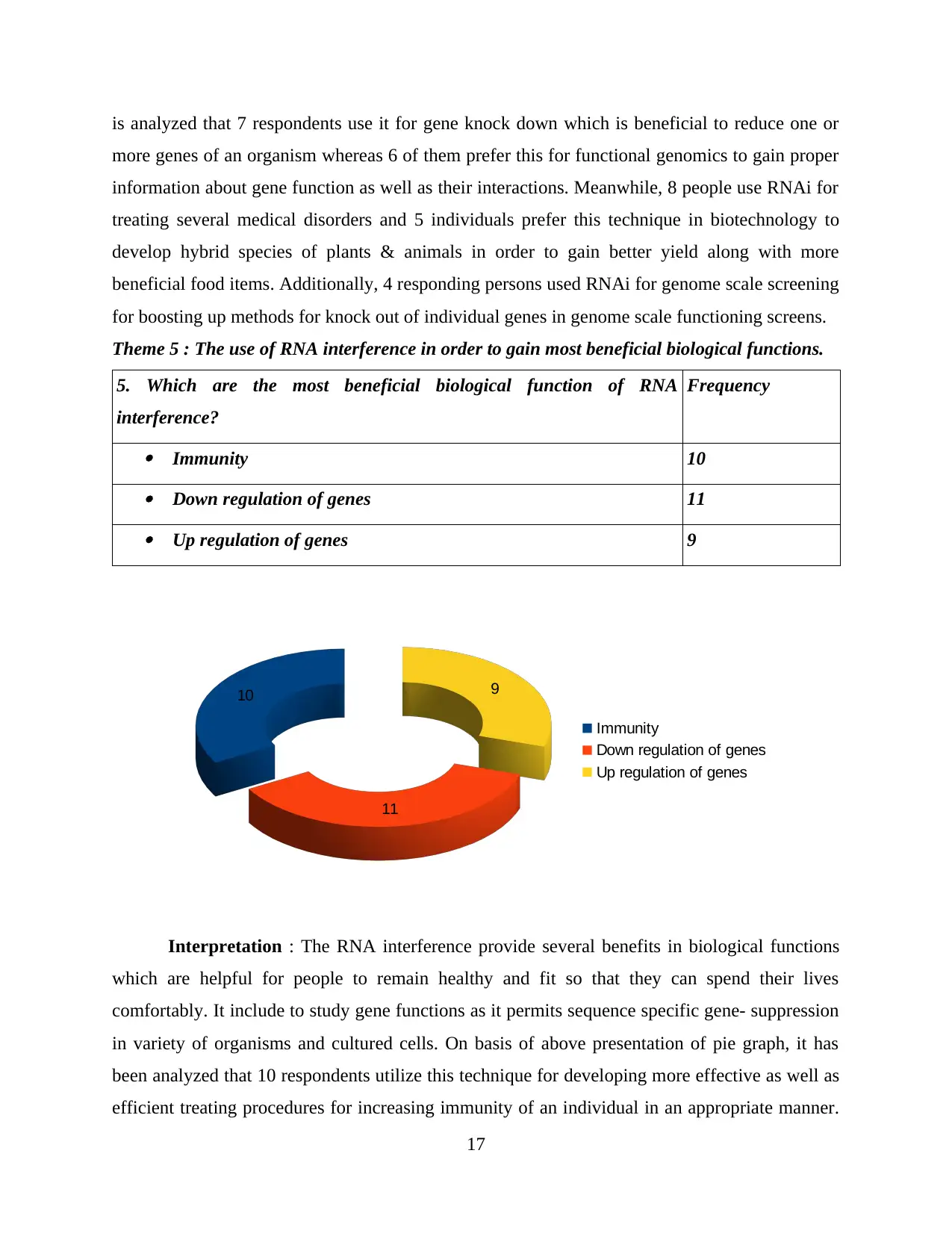
is analyzed that 7 respondents use it for gene knock down which is beneficial to reduce one or
more genes of an organism whereas 6 of them prefer this for functional genomics to gain proper
information about gene function as well as their interactions. Meanwhile, 8 people use RNAi for
treating several medical disorders and 5 individuals prefer this technique in biotechnology to
develop hybrid species of plants & animals in order to gain better yield along with more
beneficial food items. Additionally, 4 responding persons used RNAi for genome scale screening
for boosting up methods for knock out of individual genes in genome scale functioning screens.
Theme 5 : The use of RNA interference in order to gain most beneficial biological functions.
5. Which are the most beneficial biological function of RNA
interference?
Frequency
Immunity 10 Down regulation of genes 11 Up regulation of genes 9
Interpretation : The RNA interference provide several benefits in biological functions
which are helpful for people to remain healthy and fit so that they can spend their lives
comfortably. It include to study gene functions as it permits sequence specific gene- suppression
in variety of organisms and cultured cells. On basis of above presentation of pie graph, it has
been analyzed that 10 respondents utilize this technique for developing more effective as well as
efficient treating procedures for increasing immunity of an individual in an appropriate manner.
17
10
11
9
Immunity
Down regulation of genes
Up regulation of genes
more genes of an organism whereas 6 of them prefer this for functional genomics to gain proper
information about gene function as well as their interactions. Meanwhile, 8 people use RNAi for
treating several medical disorders and 5 individuals prefer this technique in biotechnology to
develop hybrid species of plants & animals in order to gain better yield along with more
beneficial food items. Additionally, 4 responding persons used RNAi for genome scale screening
for boosting up methods for knock out of individual genes in genome scale functioning screens.
Theme 5 : The use of RNA interference in order to gain most beneficial biological functions.
5. Which are the most beneficial biological function of RNA
interference?
Frequency
Immunity 10 Down regulation of genes 11 Up regulation of genes 9
Interpretation : The RNA interference provide several benefits in biological functions
which are helpful for people to remain healthy and fit so that they can spend their lives
comfortably. It include to study gene functions as it permits sequence specific gene- suppression
in variety of organisms and cultured cells. On basis of above presentation of pie graph, it has
been analyzed that 10 respondents utilize this technique for developing more effective as well as
efficient treating procedures for increasing immunity of an individual in an appropriate manner.
17
10
11
9
Immunity
Down regulation of genes
Up regulation of genes
Paraphrase This Document
Need a fresh take? Get an instant paraphrase of this document with our AI Paraphraser
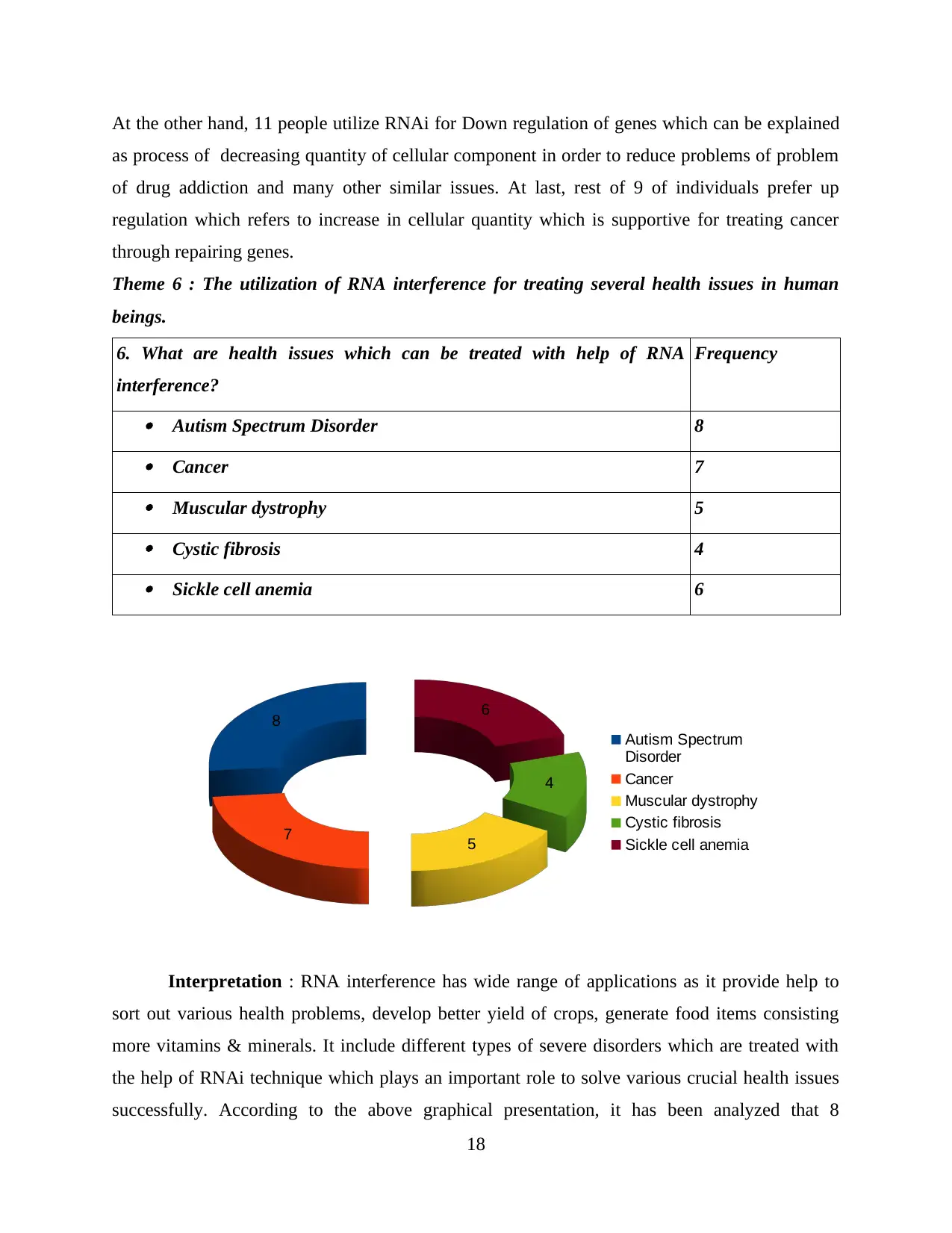
At the other hand, 11 people utilize RNAi for Down regulation of genes which can be explained
as process of decreasing quantity of cellular component in order to reduce problems of problem
of drug addiction and many other similar issues. At last, rest of 9 of individuals prefer up
regulation which refers to increase in cellular quantity which is supportive for treating cancer
through repairing genes.
Theme 6 : The utilization of RNA interference for treating several health issues in human
beings.
6. What are health issues which can be treated with help of RNA
interference?
Frequency
Autism Spectrum Disorder 8 Cancer 7 Muscular dystrophy 5 Cystic fibrosis 4 Sickle cell anemia 6
Interpretation : RNA interference has wide range of applications as it provide help to
sort out various health problems, develop better yield of crops, generate food items consisting
more vitamins & minerals. It include different types of severe disorders which are treated with
the help of RNAi technique which plays an important role to solve various crucial health issues
successfully. According to the above graphical presentation, it has been analyzed that 8
18
8
7 5
4
6
Autism Spectrum
Disorder
Cancer
Muscular dystrophy
Cystic fibrosis
Sickle cell anemia
as process of decreasing quantity of cellular component in order to reduce problems of problem
of drug addiction and many other similar issues. At last, rest of 9 of individuals prefer up
regulation which refers to increase in cellular quantity which is supportive for treating cancer
through repairing genes.
Theme 6 : The utilization of RNA interference for treating several health issues in human
beings.
6. What are health issues which can be treated with help of RNA
interference?
Frequency
Autism Spectrum Disorder 8 Cancer 7 Muscular dystrophy 5 Cystic fibrosis 4 Sickle cell anemia 6
Interpretation : RNA interference has wide range of applications as it provide help to
sort out various health problems, develop better yield of crops, generate food items consisting
more vitamins & minerals. It include different types of severe disorders which are treated with
the help of RNAi technique which plays an important role to solve various crucial health issues
successfully. According to the above graphical presentation, it has been analyzed that 8
18
8
7 5
4
6
Autism Spectrum
Disorder
Cancer
Muscular dystrophy
Cystic fibrosis
Sickle cell anemia
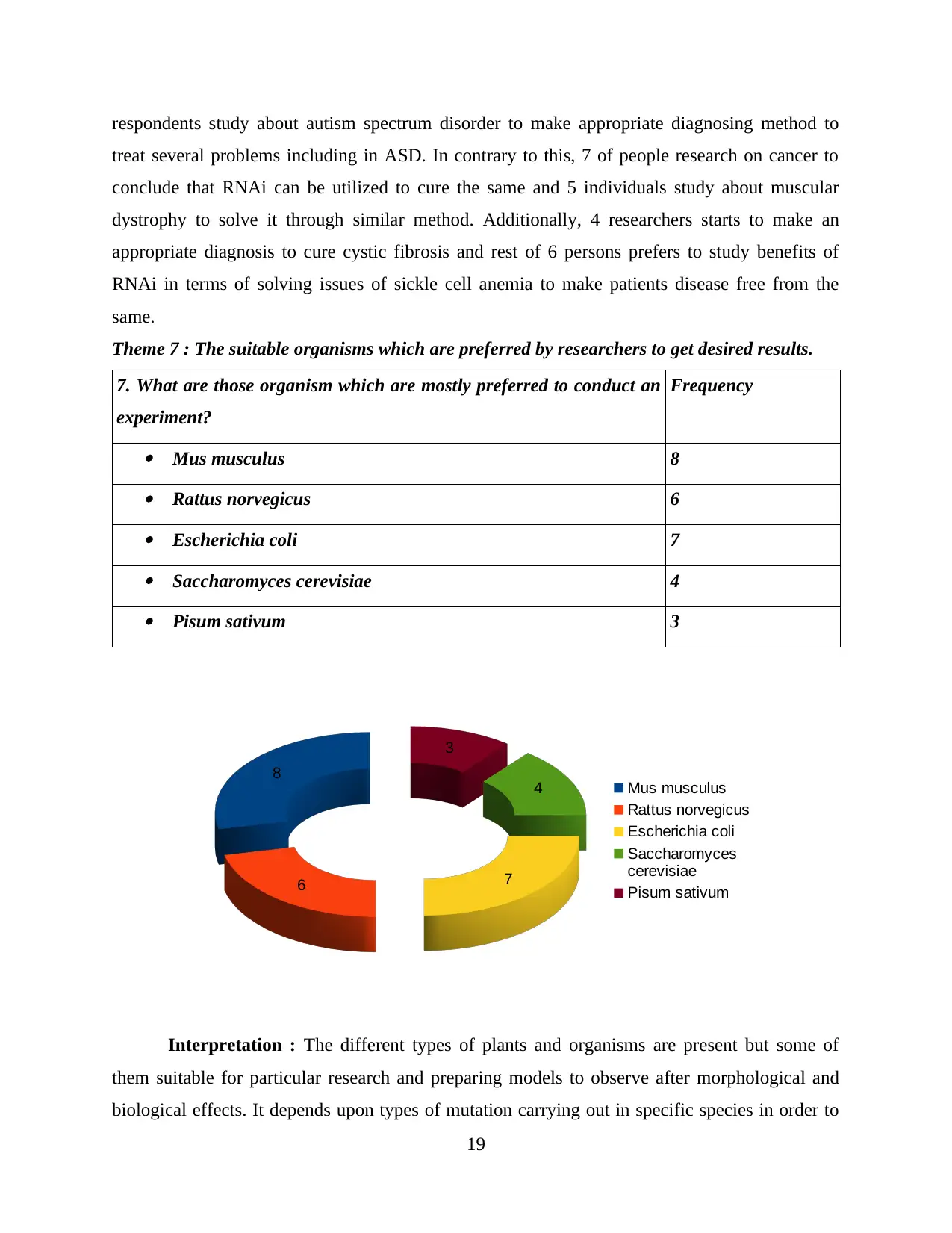
respondents study about autism spectrum disorder to make appropriate diagnosing method to
treat several problems including in ASD. In contrary to this, 7 of people research on cancer to
conclude that RNAi can be utilized to cure the same and 5 individuals study about muscular
dystrophy to solve it through similar method. Additionally, 4 researchers starts to make an
appropriate diagnosis to cure cystic fibrosis and rest of 6 persons prefers to study benefits of
RNAi in terms of solving issues of sickle cell anemia to make patients disease free from the
same.
Theme 7 : The suitable organisms which are preferred by researchers to get desired results.
7. What are those organism which are mostly preferred to conduct an
experiment?
Frequency
Mus musculus 8 Rattus norvegicus 6 Escherichia coli 7 Saccharomyces cerevisiae 4 Pisum sativum 3
Interpretation : The different types of plants and organisms are present but some of
them suitable for particular research and preparing models to observe after morphological and
biological effects. It depends upon types of mutation carrying out in specific species in order to
19
8
6 7
4
3
Mus musculus
Rattus norvegicus
Escherichia coli
Saccharomyces
cerevisiae
Pisum sativum
treat several problems including in ASD. In contrary to this, 7 of people research on cancer to
conclude that RNAi can be utilized to cure the same and 5 individuals study about muscular
dystrophy to solve it through similar method. Additionally, 4 researchers starts to make an
appropriate diagnosis to cure cystic fibrosis and rest of 6 persons prefers to study benefits of
RNAi in terms of solving issues of sickle cell anemia to make patients disease free from the
same.
Theme 7 : The suitable organisms which are preferred by researchers to get desired results.
7. What are those organism which are mostly preferred to conduct an
experiment?
Frequency
Mus musculus 8 Rattus norvegicus 6 Escherichia coli 7 Saccharomyces cerevisiae 4 Pisum sativum 3
Interpretation : The different types of plants and organisms are present but some of
them suitable for particular research and preparing models to observe after morphological and
biological effects. It depends upon types of mutation carrying out in specific species in order to
19
8
6 7
4
3
Mus musculus
Rattus norvegicus
Escherichia coli
Saccharomyces
cerevisiae
Pisum sativum
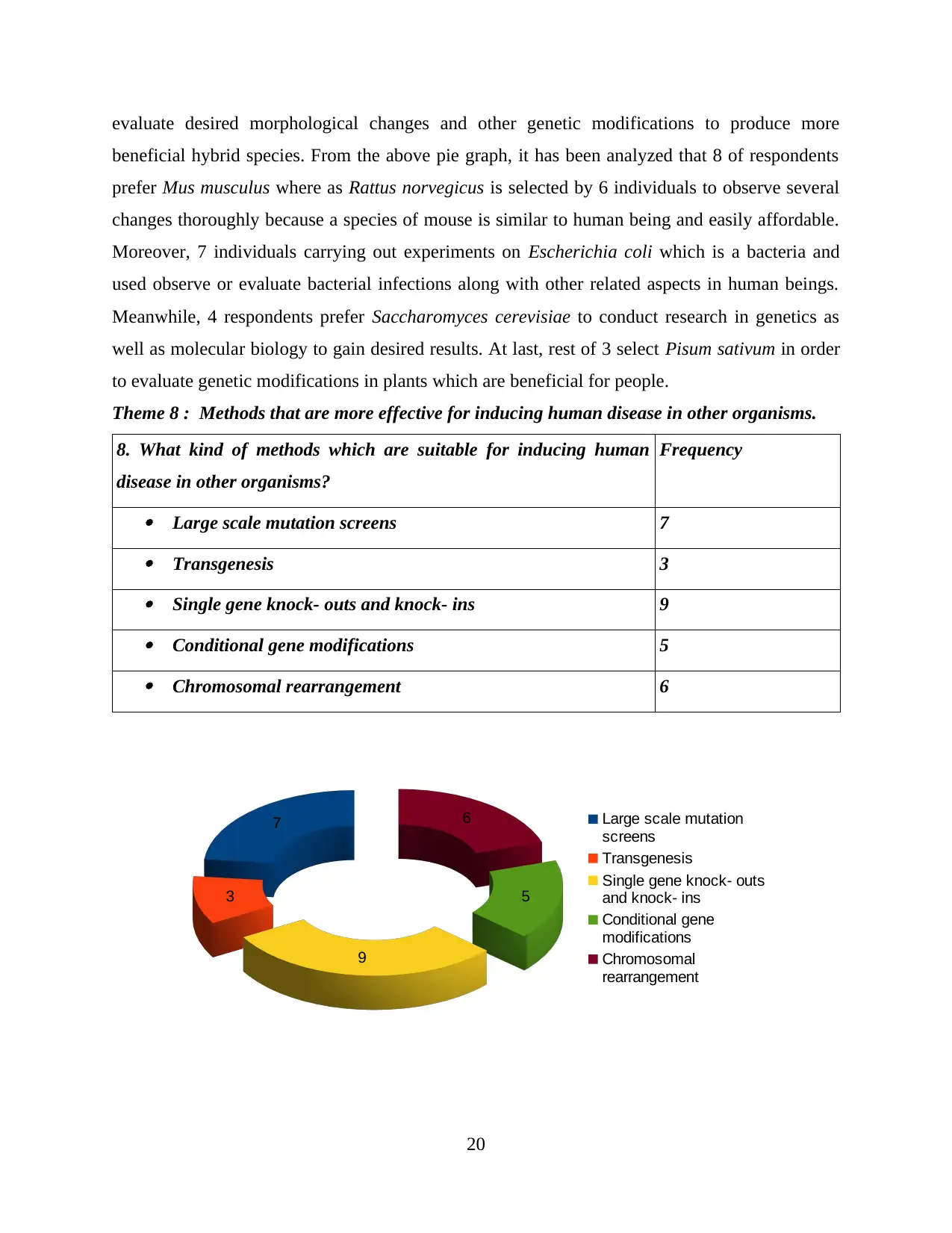
evaluate desired morphological changes and other genetic modifications to produce more
beneficial hybrid species. From the above pie graph, it has been analyzed that 8 of respondents
prefer Mus musculus where as Rattus norvegicus is selected by 6 individuals to observe several
changes thoroughly because a species of mouse is similar to human being and easily affordable.
Moreover, 7 individuals carrying out experiments on Escherichia coli which is a bacteria and
used observe or evaluate bacterial infections along with other related aspects in human beings.
Meanwhile, 4 respondents prefer Saccharomyces cerevisiae to conduct research in genetics as
well as molecular biology to gain desired results. At last, rest of 3 select Pisum sativum in order
to evaluate genetic modifications in plants which are beneficial for people.
Theme 8 : Methods that are more effective for inducing human disease in other organisms.
8. What kind of methods which are suitable for inducing human
disease in other organisms?
Frequency
Large scale mutation screens 7 Transgenesis 3 Single gene knock- outs and knock- ins 9 Conditional gene modifications 5 Chromosomal rearrangement 6
20
7
3
9
5
6 Large scale mutation
screens
Transgenesis
Single gene knock- outs
and knock- ins
Conditional gene
modifications
Chromosomal
rearrangement
beneficial hybrid species. From the above pie graph, it has been analyzed that 8 of respondents
prefer Mus musculus where as Rattus norvegicus is selected by 6 individuals to observe several
changes thoroughly because a species of mouse is similar to human being and easily affordable.
Moreover, 7 individuals carrying out experiments on Escherichia coli which is a bacteria and
used observe or evaluate bacterial infections along with other related aspects in human beings.
Meanwhile, 4 respondents prefer Saccharomyces cerevisiae to conduct research in genetics as
well as molecular biology to gain desired results. At last, rest of 3 select Pisum sativum in order
to evaluate genetic modifications in plants which are beneficial for people.
Theme 8 : Methods that are more effective for inducing human disease in other organisms.
8. What kind of methods which are suitable for inducing human
disease in other organisms?
Frequency
Large scale mutation screens 7 Transgenesis 3 Single gene knock- outs and knock- ins 9 Conditional gene modifications 5 Chromosomal rearrangement 6
20
7
3
9
5
6 Large scale mutation
screens
Transgenesis
Single gene knock- outs
and knock- ins
Conditional gene
modifications
Chromosomal
rearrangement
Secure Best Marks with AI Grader
Need help grading? Try our AI Grader for instant feedback on your assignments.
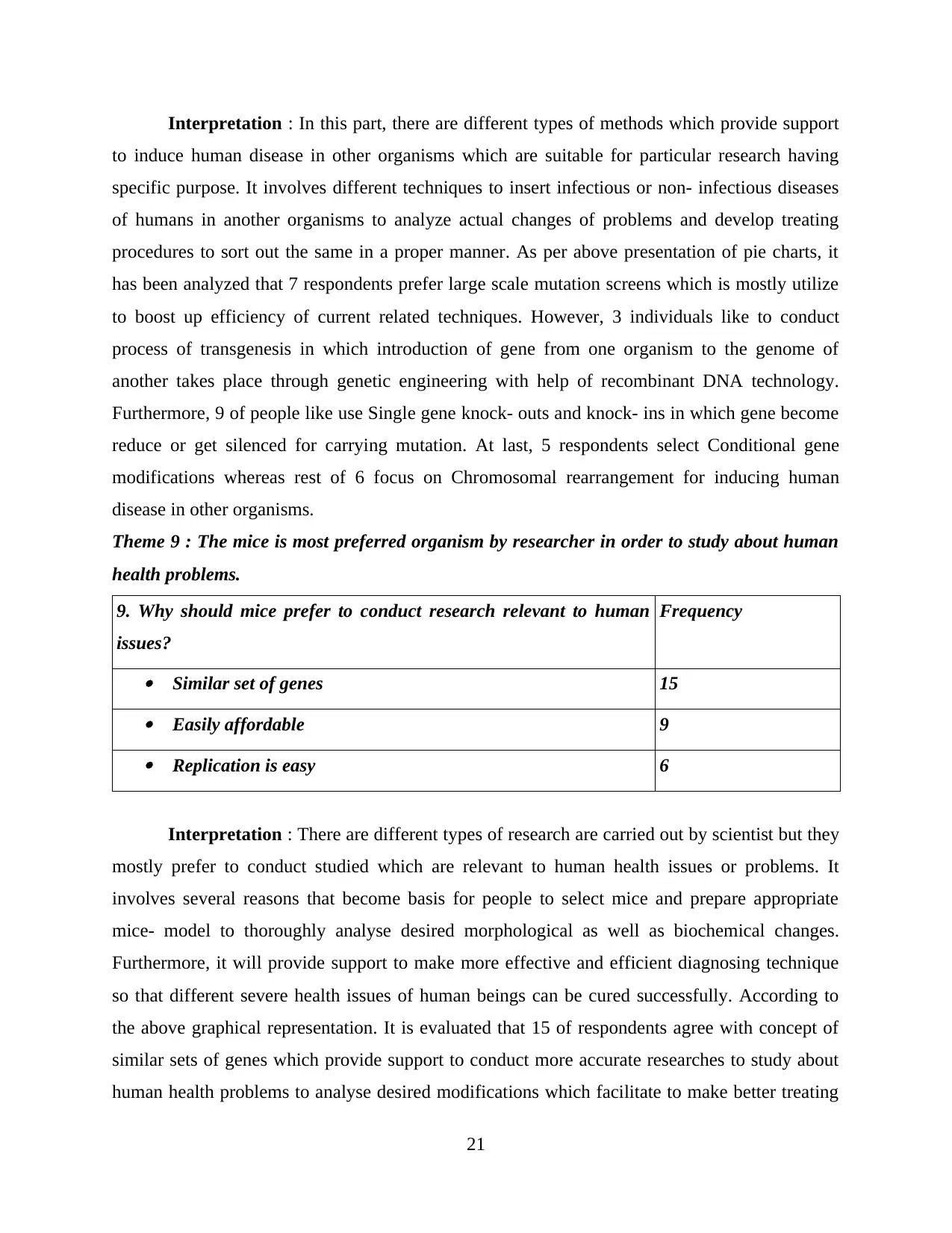
Interpretation : In this part, there are different types of methods which provide support
to induce human disease in other organisms which are suitable for particular research having
specific purpose. It involves different techniques to insert infectious or non- infectious diseases
of humans in another organisms to analyze actual changes of problems and develop treating
procedures to sort out the same in a proper manner. As per above presentation of pie charts, it
has been analyzed that 7 respondents prefer large scale mutation screens which is mostly utilize
to boost up efficiency of current related techniques. However, 3 individuals like to conduct
process of transgenesis in which introduction of gene from one organism to the genome of
another takes place through genetic engineering with help of recombinant DNA technology.
Furthermore, 9 of people like use Single gene knock- outs and knock- ins in which gene become
reduce or get silenced for carrying mutation. At last, 5 respondents select Conditional gene
modifications whereas rest of 6 focus on Chromosomal rearrangement for inducing human
disease in other organisms.
Theme 9 : The mice is most preferred organism by researcher in order to study about human
health problems.
9. Why should mice prefer to conduct research relevant to human
issues?
Frequency
Similar set of genes 15 Easily affordable 9 Replication is easy 6
Interpretation : There are different types of research are carried out by scientist but they
mostly prefer to conduct studied which are relevant to human health issues or problems. It
involves several reasons that become basis for people to select mice and prepare appropriate
mice- model to thoroughly analyse desired morphological as well as biochemical changes.
Furthermore, it will provide support to make more effective and efficient diagnosing technique
so that different severe health issues of human beings can be cured successfully. According to
the above graphical representation. It is evaluated that 15 of respondents agree with concept of
similar sets of genes which provide support to conduct more accurate researches to study about
human health problems to analyse desired modifications which facilitate to make better treating
21
to induce human disease in other organisms which are suitable for particular research having
specific purpose. It involves different techniques to insert infectious or non- infectious diseases
of humans in another organisms to analyze actual changes of problems and develop treating
procedures to sort out the same in a proper manner. As per above presentation of pie charts, it
has been analyzed that 7 respondents prefer large scale mutation screens which is mostly utilize
to boost up efficiency of current related techniques. However, 3 individuals like to conduct
process of transgenesis in which introduction of gene from one organism to the genome of
another takes place through genetic engineering with help of recombinant DNA technology.
Furthermore, 9 of people like use Single gene knock- outs and knock- ins in which gene become
reduce or get silenced for carrying mutation. At last, 5 respondents select Conditional gene
modifications whereas rest of 6 focus on Chromosomal rearrangement for inducing human
disease in other organisms.
Theme 9 : The mice is most preferred organism by researcher in order to study about human
health problems.
9. Why should mice prefer to conduct research relevant to human
issues?
Frequency
Similar set of genes 15 Easily affordable 9 Replication is easy 6
Interpretation : There are different types of research are carried out by scientist but they
mostly prefer to conduct studied which are relevant to human health issues or problems. It
involves several reasons that become basis for people to select mice and prepare appropriate
mice- model to thoroughly analyse desired morphological as well as biochemical changes.
Furthermore, it will provide support to make more effective and efficient diagnosing technique
so that different severe health issues of human beings can be cured successfully. According to
the above graphical representation. It is evaluated that 15 of respondents agree with concept of
similar sets of genes which provide support to conduct more accurate researches to study about
human health problems to analyse desired modifications which facilitate to make better treating
21
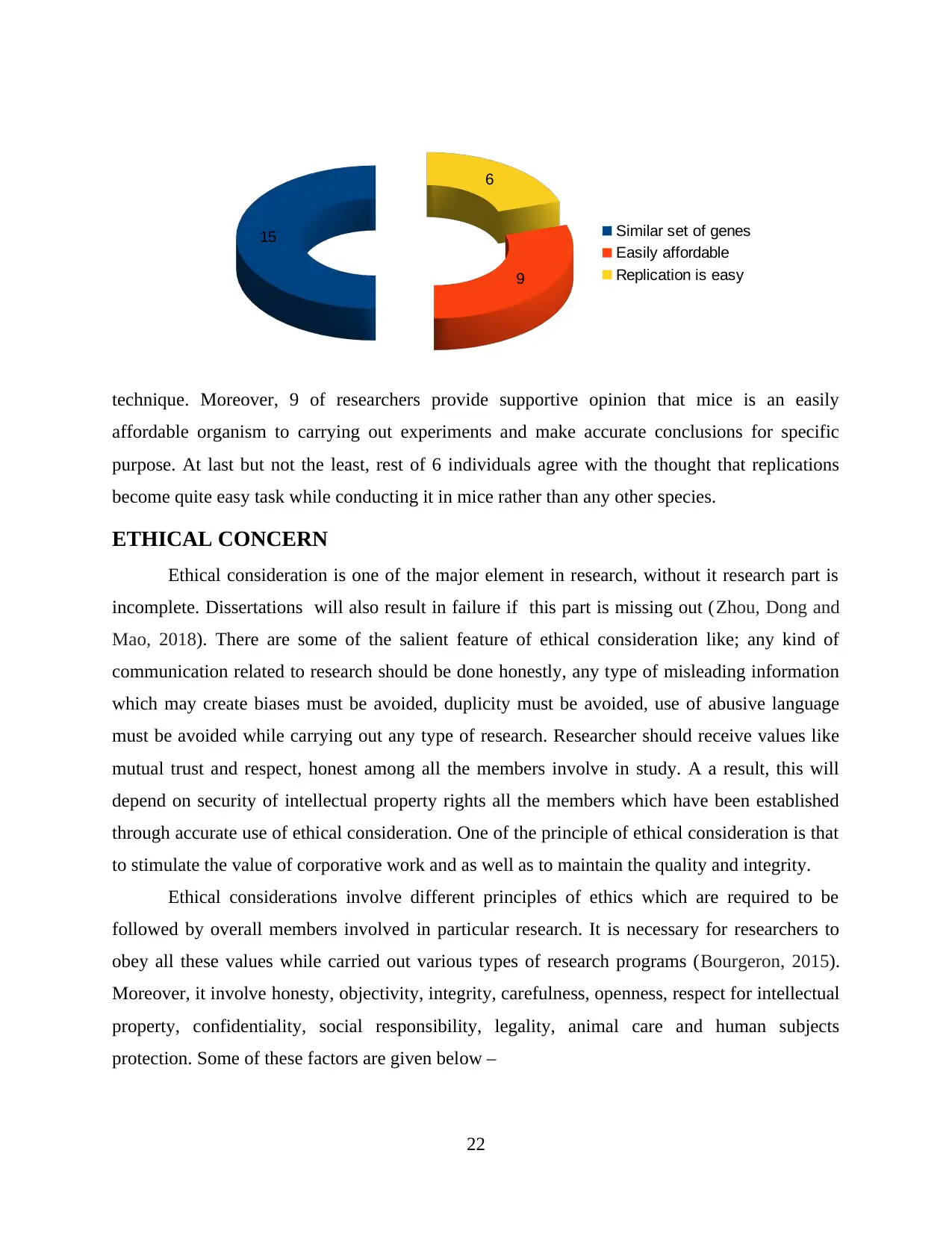
technique. Moreover, 9 of researchers provide supportive opinion that mice is an easily
affordable organism to carrying out experiments and make accurate conclusions for specific
purpose. At last but not the least, rest of 6 individuals agree with the thought that replications
become quite easy task while conducting it in mice rather than any other species.
ETHICAL CONCERN
Ethical consideration is one of the major element in research, without it research part is
incomplete. Dissertations will also result in failure if this part is missing out (Zhou, Dong and
Mao, 2018). There are some of the salient feature of ethical consideration like; any kind of
communication related to research should be done honestly, any type of misleading information
which may create biases must be avoided, duplicity must be avoided, use of abusive language
must be avoided while carrying out any type of research. Researcher should receive values like
mutual trust and respect, honest among all the members involve in study. A a result, this will
depend on security of intellectual property rights all the members which have been established
through accurate use of ethical consideration. One of the principle of ethical consideration is that
to stimulate the value of corporative work and as well as to maintain the quality and integrity.
Ethical considerations involve different principles of ethics which are required to be
followed by overall members involved in particular research. It is necessary for researchers to
obey all these values while carried out various types of research programs (Bourgeron, 2015).
Moreover, it involve honesty, objectivity, integrity, carefulness, openness, respect for intellectual
property, confidentiality, social responsibility, legality, animal care and human subjects
protection. Some of these factors are given below –
22
15
9
6
Similar set of genes
Easily affordable
Replication is easy
affordable organism to carrying out experiments and make accurate conclusions for specific
purpose. At last but not the least, rest of 6 individuals agree with the thought that replications
become quite easy task while conducting it in mice rather than any other species.
ETHICAL CONCERN
Ethical consideration is one of the major element in research, without it research part is
incomplete. Dissertations will also result in failure if this part is missing out (Zhou, Dong and
Mao, 2018). There are some of the salient feature of ethical consideration like; any kind of
communication related to research should be done honestly, any type of misleading information
which may create biases must be avoided, duplicity must be avoided, use of abusive language
must be avoided while carrying out any type of research. Researcher should receive values like
mutual trust and respect, honest among all the members involve in study. A a result, this will
depend on security of intellectual property rights all the members which have been established
through accurate use of ethical consideration. One of the principle of ethical consideration is that
to stimulate the value of corporative work and as well as to maintain the quality and integrity.
Ethical considerations involve different principles of ethics which are required to be
followed by overall members involved in particular research. It is necessary for researchers to
obey all these values while carried out various types of research programs (Bourgeron, 2015).
Moreover, it involve honesty, objectivity, integrity, carefulness, openness, respect for intellectual
property, confidentiality, social responsibility, legality, animal care and human subjects
protection. Some of these factors are given below –
22
15
9
6
Similar set of genes
Easily affordable
Replication is easy
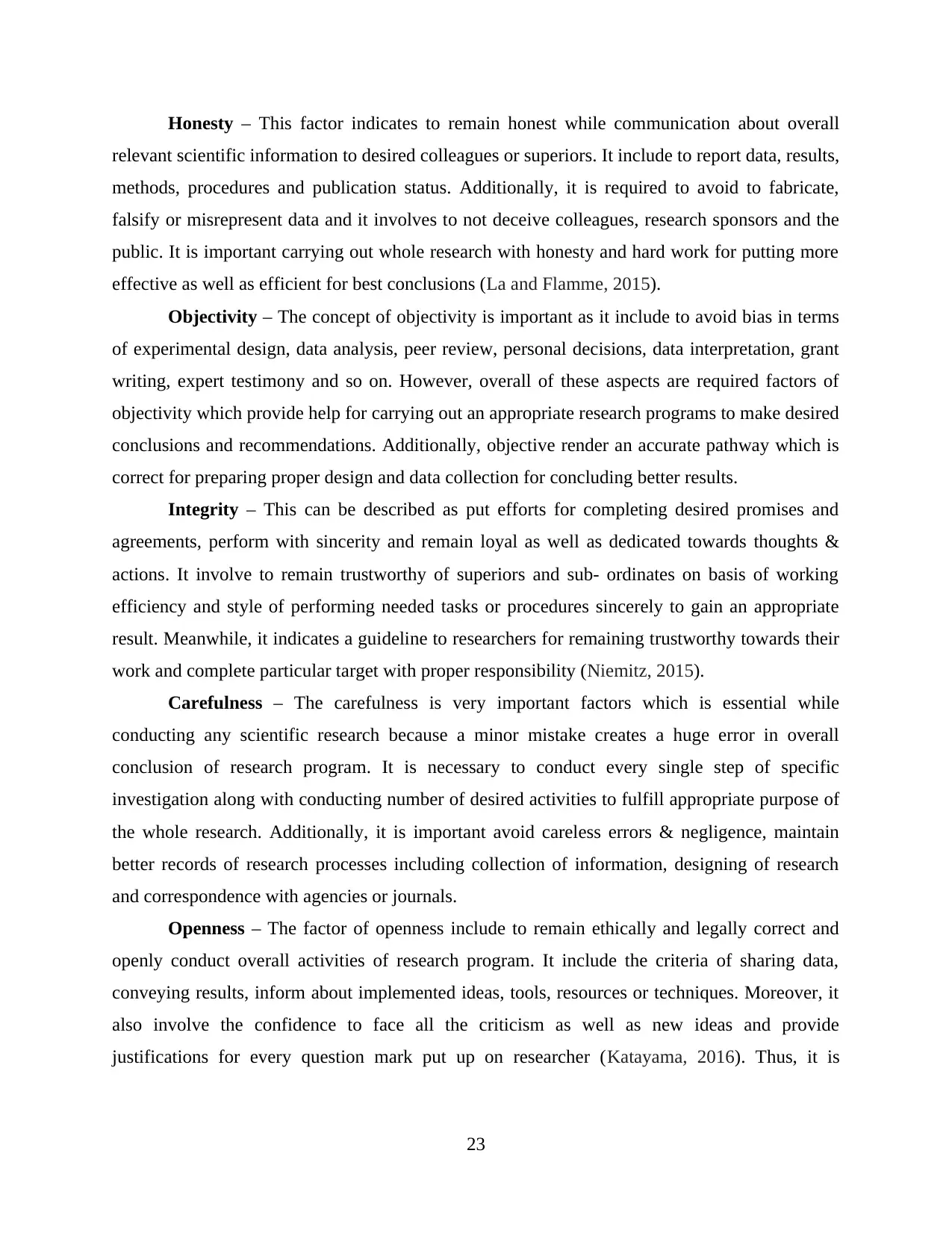
Honesty – This factor indicates to remain honest while communication about overall
relevant scientific information to desired colleagues or superiors. It include to report data, results,
methods, procedures and publication status. Additionally, it is required to avoid to fabricate,
falsify or misrepresent data and it involves to not deceive colleagues, research sponsors and the
public. It is important carrying out whole research with honesty and hard work for putting more
effective as well as efficient for best conclusions (La and Flamme, 2015).
Objectivity – The concept of objectivity is important as it include to avoid bias in terms
of experimental design, data analysis, peer review, personal decisions, data interpretation, grant
writing, expert testimony and so on. However, overall of these aspects are required factors of
objectivity which provide help for carrying out an appropriate research programs to make desired
conclusions and recommendations. Additionally, objective render an accurate pathway which is
correct for preparing proper design and data collection for concluding better results.
Integrity – This can be described as put efforts for completing desired promises and
agreements, perform with sincerity and remain loyal as well as dedicated towards thoughts &
actions. It involve to remain trustworthy of superiors and sub- ordinates on basis of working
efficiency and style of performing needed tasks or procedures sincerely to gain an appropriate
result. Meanwhile, it indicates a guideline to researchers for remaining trustworthy towards their
work and complete particular target with proper responsibility (Niemitz, 2015).
Carefulness – The carefulness is very important factors which is essential while
conducting any scientific research because a minor mistake creates a huge error in overall
conclusion of research program. It is necessary to conduct every single step of specific
investigation along with conducting number of desired activities to fulfill appropriate purpose of
the whole research. Additionally, it is important avoid careless errors & negligence, maintain
better records of research processes including collection of information, designing of research
and correspondence with agencies or journals.
Openness – The factor of openness include to remain ethically and legally correct and
openly conduct overall activities of research program. It include the criteria of sharing data,
conveying results, inform about implemented ideas, tools, resources or techniques. Moreover, it
also involve the confidence to face all the criticism as well as new ideas and provide
justifications for every question mark put up on researcher (Katayama, 2016). Thus, it is
23
relevant scientific information to desired colleagues or superiors. It include to report data, results,
methods, procedures and publication status. Additionally, it is required to avoid to fabricate,
falsify or misrepresent data and it involves to not deceive colleagues, research sponsors and the
public. It is important carrying out whole research with honesty and hard work for putting more
effective as well as efficient for best conclusions (La and Flamme, 2015).
Objectivity – The concept of objectivity is important as it include to avoid bias in terms
of experimental design, data analysis, peer review, personal decisions, data interpretation, grant
writing, expert testimony and so on. However, overall of these aspects are required factors of
objectivity which provide help for carrying out an appropriate research programs to make desired
conclusions and recommendations. Additionally, objective render an accurate pathway which is
correct for preparing proper design and data collection for concluding better results.
Integrity – This can be described as put efforts for completing desired promises and
agreements, perform with sincerity and remain loyal as well as dedicated towards thoughts &
actions. It involve to remain trustworthy of superiors and sub- ordinates on basis of working
efficiency and style of performing needed tasks or procedures sincerely to gain an appropriate
result. Meanwhile, it indicates a guideline to researchers for remaining trustworthy towards their
work and complete particular target with proper responsibility (Niemitz, 2015).
Carefulness – The carefulness is very important factors which is essential while
conducting any scientific research because a minor mistake creates a huge error in overall
conclusion of research program. It is necessary to conduct every single step of specific
investigation along with conducting number of desired activities to fulfill appropriate purpose of
the whole research. Additionally, it is important avoid careless errors & negligence, maintain
better records of research processes including collection of information, designing of research
and correspondence with agencies or journals.
Openness – The factor of openness include to remain ethically and legally correct and
openly conduct overall activities of research program. It include the criteria of sharing data,
conveying results, inform about implemented ideas, tools, resources or techniques. Moreover, it
also involve the confidence to face all the criticism as well as new ideas and provide
justifications for every question mark put up on researcher (Katayama, 2016). Thus, it is
23
Paraphrase This Document
Need a fresh take? Get an instant paraphrase of this document with our AI Paraphraser
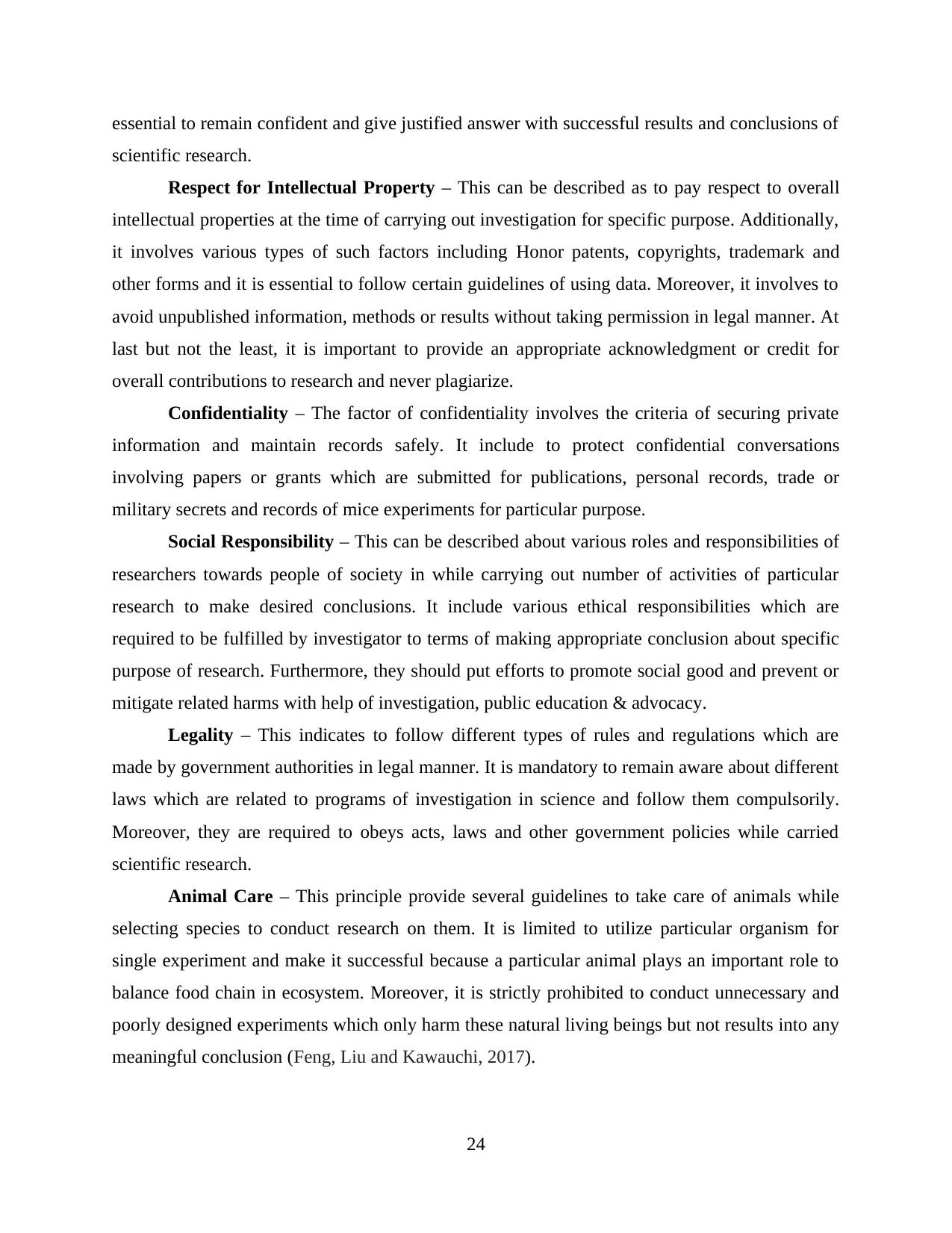
essential to remain confident and give justified answer with successful results and conclusions of
scientific research.
Respect for Intellectual Property – This can be described as to pay respect to overall
intellectual properties at the time of carrying out investigation for specific purpose. Additionally,
it involves various types of such factors including Honor patents, copyrights, trademark and
other forms and it is essential to follow certain guidelines of using data. Moreover, it involves to
avoid unpublished information, methods or results without taking permission in legal manner. At
last but not the least, it is important to provide an appropriate acknowledgment or credit for
overall contributions to research and never plagiarize.
Confidentiality – The factor of confidentiality involves the criteria of securing private
information and maintain records safely. It include to protect confidential conversations
involving papers or grants which are submitted for publications, personal records, trade or
military secrets and records of mice experiments for particular purpose.
Social Responsibility – This can be described about various roles and responsibilities of
researchers towards people of society in while carrying out number of activities of particular
research to make desired conclusions. It include various ethical responsibilities which are
required to be fulfilled by investigator to terms of making appropriate conclusion about specific
purpose of research. Furthermore, they should put efforts to promote social good and prevent or
mitigate related harms with help of investigation, public education & advocacy.
Legality – This indicates to follow different types of rules and regulations which are
made by government authorities in legal manner. It is mandatory to remain aware about different
laws which are related to programs of investigation in science and follow them compulsorily.
Moreover, they are required to obeys acts, laws and other government policies while carried
scientific research.
Animal Care – This principle provide several guidelines to take care of animals while
selecting species to conduct research on them. It is limited to utilize particular organism for
single experiment and make it successful because a particular animal plays an important role to
balance food chain in ecosystem. Moreover, it is strictly prohibited to conduct unnecessary and
poorly designed experiments which only harm these natural living beings but not results into any
meaningful conclusion (Feng, Liu and Kawauchi, 2017).
24
scientific research.
Respect for Intellectual Property – This can be described as to pay respect to overall
intellectual properties at the time of carrying out investigation for specific purpose. Additionally,
it involves various types of such factors including Honor patents, copyrights, trademark and
other forms and it is essential to follow certain guidelines of using data. Moreover, it involves to
avoid unpublished information, methods or results without taking permission in legal manner. At
last but not the least, it is important to provide an appropriate acknowledgment or credit for
overall contributions to research and never plagiarize.
Confidentiality – The factor of confidentiality involves the criteria of securing private
information and maintain records safely. It include to protect confidential conversations
involving papers or grants which are submitted for publications, personal records, trade or
military secrets and records of mice experiments for particular purpose.
Social Responsibility – This can be described about various roles and responsibilities of
researchers towards people of society in while carrying out number of activities of particular
research to make desired conclusions. It include various ethical responsibilities which are
required to be fulfilled by investigator to terms of making appropriate conclusion about specific
purpose of research. Furthermore, they should put efforts to promote social good and prevent or
mitigate related harms with help of investigation, public education & advocacy.
Legality – This indicates to follow different types of rules and regulations which are
made by government authorities in legal manner. It is mandatory to remain aware about different
laws which are related to programs of investigation in science and follow them compulsorily.
Moreover, they are required to obeys acts, laws and other government policies while carried
scientific research.
Animal Care – This principle provide several guidelines to take care of animals while
selecting species to conduct research on them. It is limited to utilize particular organism for
single experiment and make it successful because a particular animal plays an important role to
balance food chain in ecosystem. Moreover, it is strictly prohibited to conduct unnecessary and
poorly designed experiments which only harm these natural living beings but not results into any
meaningful conclusion (Feng, Liu and Kawauchi, 2017).
24
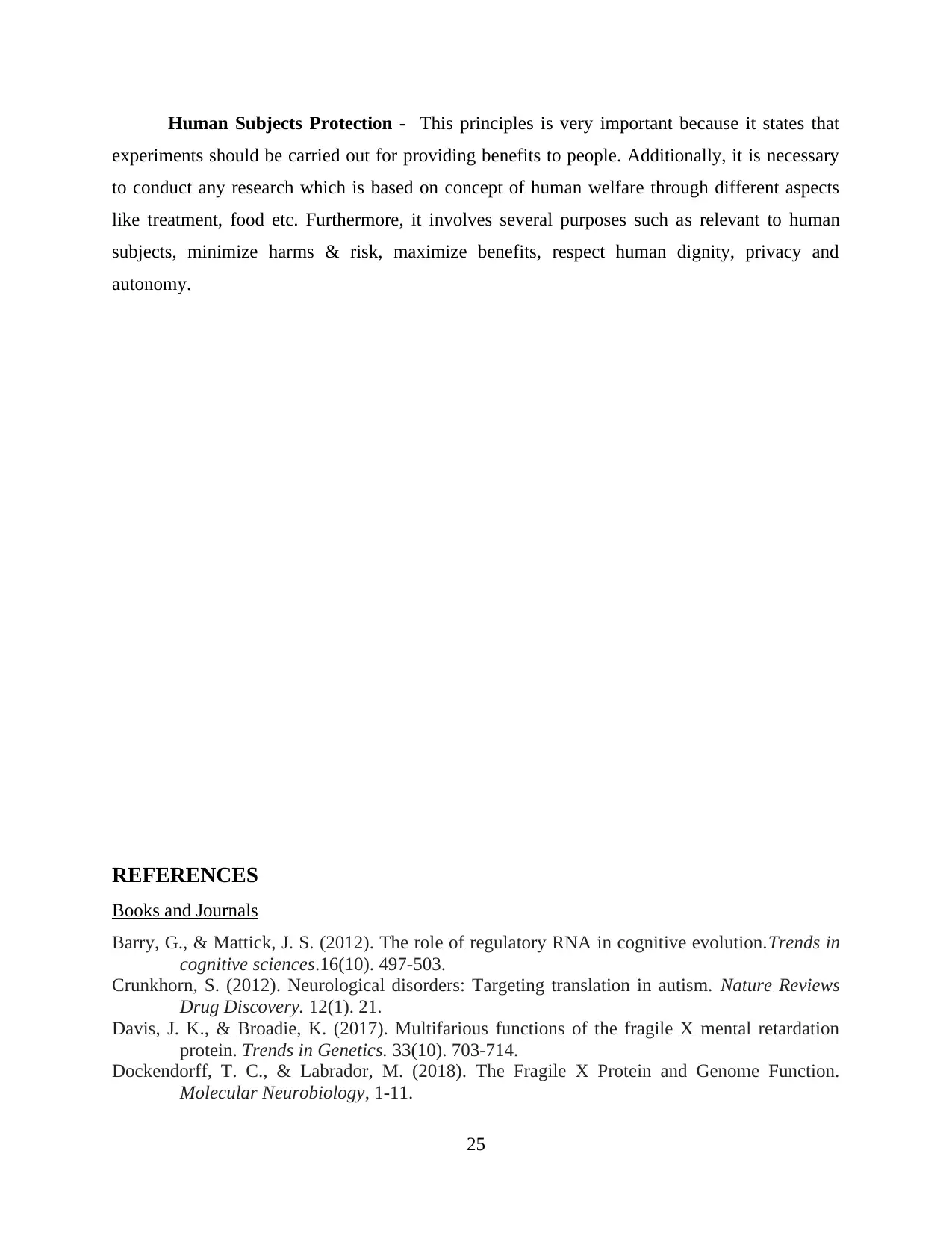
Human Subjects Protection - This principles is very important because it states that
experiments should be carried out for providing benefits to people. Additionally, it is necessary
to conduct any research which is based on concept of human welfare through different aspects
like treatment, food etc. Furthermore, it involves several purposes such as relevant to human
subjects, minimize harms & risk, maximize benefits, respect human dignity, privacy and
autonomy.
REFERENCES
Books and Journals
Barry, G., & Mattick, J. S. (2012). The role of regulatory RNA in cognitive evolution.Trends in
cognitive sciences.16(10). 497-503.
Crunkhorn, S. (2012). Neurological disorders: Targeting translation in autism. Nature Reviews
Drug Discovery. 12(1). 21.
Davis, J. K., & Broadie, K. (2017). Multifarious functions of the fragile X mental retardation
protein. Trends in Genetics. 33(10). 703-714.
Dockendorff, T. C., & Labrador, M. (2018). The Fragile X Protein and Genome Function.
Molecular Neurobiology, 1-11.
25
experiments should be carried out for providing benefits to people. Additionally, it is necessary
to conduct any research which is based on concept of human welfare through different aspects
like treatment, food etc. Furthermore, it involves several purposes such as relevant to human
subjects, minimize harms & risk, maximize benefits, respect human dignity, privacy and
autonomy.
REFERENCES
Books and Journals
Barry, G., & Mattick, J. S. (2012). The role of regulatory RNA in cognitive evolution.Trends in
cognitive sciences.16(10). 497-503.
Crunkhorn, S. (2012). Neurological disorders: Targeting translation in autism. Nature Reviews
Drug Discovery. 12(1). 21.
Davis, J. K., & Broadie, K. (2017). Multifarious functions of the fragile X mental retardation
protein. Trends in Genetics. 33(10). 703-714.
Dockendorff, T. C., & Labrador, M. (2018). The Fragile X Protein and Genome Function.
Molecular Neurobiology, 1-11.
25
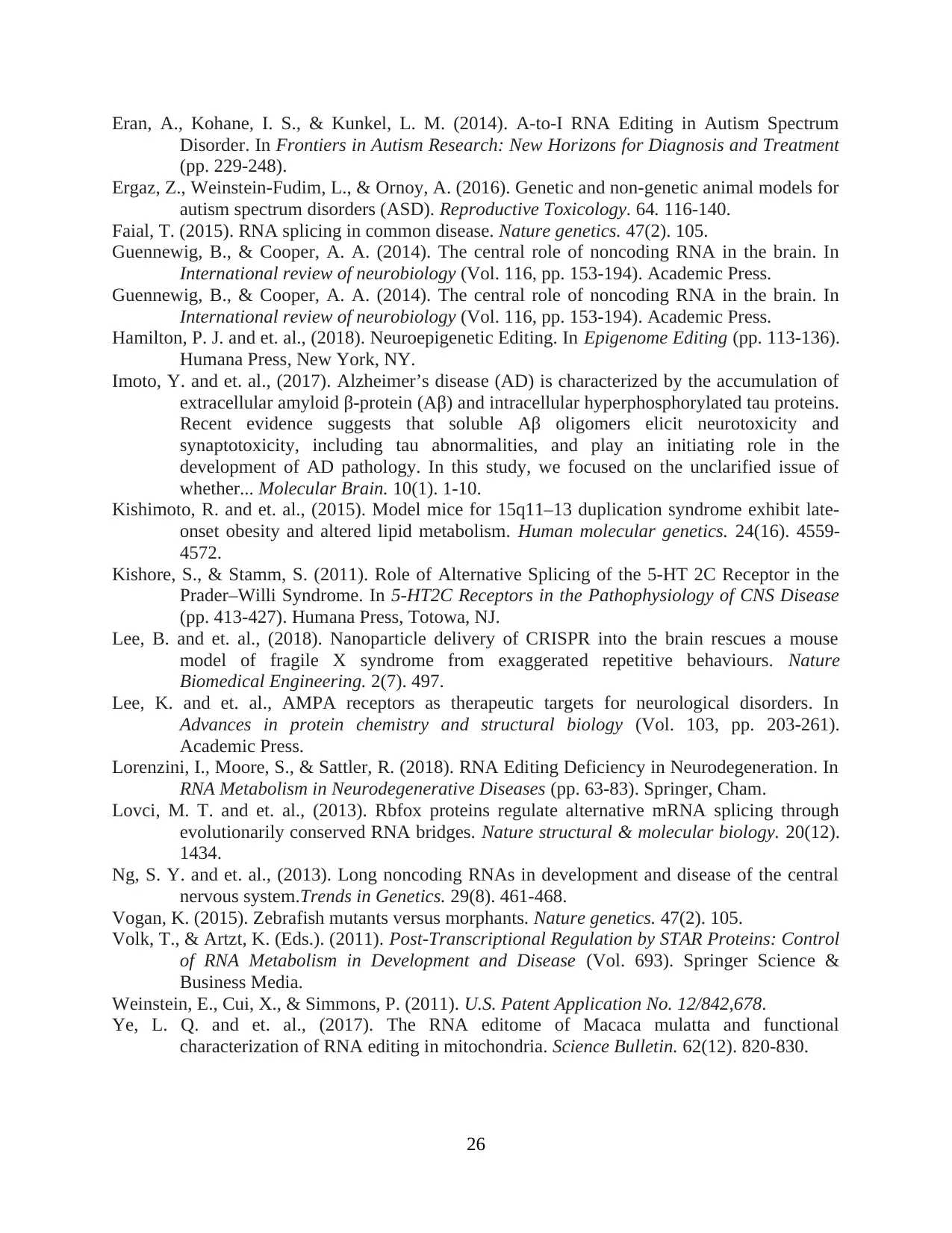
Eran, A., Kohane, I. S., & Kunkel, L. M. (2014). A-to-I RNA Editing in Autism Spectrum
Disorder. In Frontiers in Autism Research: New Horizons for Diagnosis and Treatment
(pp. 229-248).
Ergaz, Z., Weinstein-Fudim, L., & Ornoy, A. (2016). Genetic and non-genetic animal models for
autism spectrum disorders (ASD). Reproductive Toxicology. 64. 116-140.
Faial, T. (2015). RNA splicing in common disease. Nature genetics. 47(2). 105.
Guennewig, B., & Cooper, A. A. (2014). The central role of noncoding RNA in the brain. In
International review of neurobiology (Vol. 116, pp. 153-194). Academic Press.
Guennewig, B., & Cooper, A. A. (2014). The central role of noncoding RNA in the brain. In
International review of neurobiology (Vol. 116, pp. 153-194). Academic Press.
Hamilton, P. J. and et. al., (2018). Neuroepigenetic Editing. In Epigenome Editing (pp. 113-136).
Humana Press, New York, NY.
Imoto, Y. and et. al., (2017). Alzheimer’s disease (AD) is characterized by the accumulation of
extracellular amyloid β-protein (Aβ) and intracellular hyperphosphorylated tau proteins.
Recent evidence suggests that soluble Aβ oligomers elicit neurotoxicity and
synaptotoxicity, including tau abnormalities, and play an initiating role in the
development of AD pathology. In this study, we focused on the unclarified issue of
whether... Molecular Brain. 10(1). 1-10.
Kishimoto, R. and et. al., (2015). Model mice for 15q11–13 duplication syndrome exhibit late-
onset obesity and altered lipid metabolism. Human molecular genetics. 24(16). 4559-
4572.
Kishore, S., & Stamm, S. (2011). Role of Alternative Splicing of the 5-HT 2C Receptor in the
Prader–Willi Syndrome. In 5-HT2C Receptors in the Pathophysiology of CNS Disease
(pp. 413-427). Humana Press, Totowa, NJ.
Lee, B. and et. al., (2018). Nanoparticle delivery of CRISPR into the brain rescues a mouse
model of fragile X syndrome from exaggerated repetitive behaviours. Nature
Biomedical Engineering. 2(7). 497.
Lee, K. and et. al., AMPA receptors as therapeutic targets for neurological disorders. In
Advances in protein chemistry and structural biology (Vol. 103, pp. 203-261).
Academic Press.
Lorenzini, I., Moore, S., & Sattler, R. (2018). RNA Editing Deficiency in Neurodegeneration. In
RNA Metabolism in Neurodegenerative Diseases (pp. 63-83). Springer, Cham.
Lovci, M. T. and et. al., (2013). Rbfox proteins regulate alternative mRNA splicing through
evolutionarily conserved RNA bridges. Nature structural & molecular biology. 20(12).
1434.
Ng, S. Y. and et. al., (2013). Long noncoding RNAs in development and disease of the central
nervous system.Trends in Genetics. 29(8). 461-468.
Vogan, K. (2015). Zebrafish mutants versus morphants. Nature genetics. 47(2). 105.
Volk, T., & Artzt, K. (Eds.). (2011). Post‐Transcriptional Regulation by STAR Proteins: Control
of RNA Metabolism in Development and Disease (Vol. 693). Springer Science &
Business Media.
Weinstein, E., Cui, X., & Simmons, P. (2011). U.S. Patent Application No. 12/842,678.
Ye, L. Q. and et. al., (2017). The RNA editome of Macaca mulatta and functional
characterization of RNA editing in mitochondria. Science Bulletin. 62(12). 820-830.
26
Disorder. In Frontiers in Autism Research: New Horizons for Diagnosis and Treatment
(pp. 229-248).
Ergaz, Z., Weinstein-Fudim, L., & Ornoy, A. (2016). Genetic and non-genetic animal models for
autism spectrum disorders (ASD). Reproductive Toxicology. 64. 116-140.
Faial, T. (2015). RNA splicing in common disease. Nature genetics. 47(2). 105.
Guennewig, B., & Cooper, A. A. (2014). The central role of noncoding RNA in the brain. In
International review of neurobiology (Vol. 116, pp. 153-194). Academic Press.
Guennewig, B., & Cooper, A. A. (2014). The central role of noncoding RNA in the brain. In
International review of neurobiology (Vol. 116, pp. 153-194). Academic Press.
Hamilton, P. J. and et. al., (2018). Neuroepigenetic Editing. In Epigenome Editing (pp. 113-136).
Humana Press, New York, NY.
Imoto, Y. and et. al., (2017). Alzheimer’s disease (AD) is characterized by the accumulation of
extracellular amyloid β-protein (Aβ) and intracellular hyperphosphorylated tau proteins.
Recent evidence suggests that soluble Aβ oligomers elicit neurotoxicity and
synaptotoxicity, including tau abnormalities, and play an initiating role in the
development of AD pathology. In this study, we focused on the unclarified issue of
whether... Molecular Brain. 10(1). 1-10.
Kishimoto, R. and et. al., (2015). Model mice for 15q11–13 duplication syndrome exhibit late-
onset obesity and altered lipid metabolism. Human molecular genetics. 24(16). 4559-
4572.
Kishore, S., & Stamm, S. (2011). Role of Alternative Splicing of the 5-HT 2C Receptor in the
Prader–Willi Syndrome. In 5-HT2C Receptors in the Pathophysiology of CNS Disease
(pp. 413-427). Humana Press, Totowa, NJ.
Lee, B. and et. al., (2018). Nanoparticle delivery of CRISPR into the brain rescues a mouse
model of fragile X syndrome from exaggerated repetitive behaviours. Nature
Biomedical Engineering. 2(7). 497.
Lee, K. and et. al., AMPA receptors as therapeutic targets for neurological disorders. In
Advances in protein chemistry and structural biology (Vol. 103, pp. 203-261).
Academic Press.
Lorenzini, I., Moore, S., & Sattler, R. (2018). RNA Editing Deficiency in Neurodegeneration. In
RNA Metabolism in Neurodegenerative Diseases (pp. 63-83). Springer, Cham.
Lovci, M. T. and et. al., (2013). Rbfox proteins regulate alternative mRNA splicing through
evolutionarily conserved RNA bridges. Nature structural & molecular biology. 20(12).
1434.
Ng, S. Y. and et. al., (2013). Long noncoding RNAs in development and disease of the central
nervous system.Trends in Genetics. 29(8). 461-468.
Vogan, K. (2015). Zebrafish mutants versus morphants. Nature genetics. 47(2). 105.
Volk, T., & Artzt, K. (Eds.). (2011). Post‐Transcriptional Regulation by STAR Proteins: Control
of RNA Metabolism in Development and Disease (Vol. 693). Springer Science &
Business Media.
Weinstein, E., Cui, X., & Simmons, P. (2011). U.S. Patent Application No. 12/842,678.
Ye, L. Q. and et. al., (2017). The RNA editome of Macaca mulatta and functional
characterization of RNA editing in mitochondria. Science Bulletin. 62(12). 820-830.
26
Secure Best Marks with AI Grader
Need help grading? Try our AI Grader for instant feedback on your assignments.
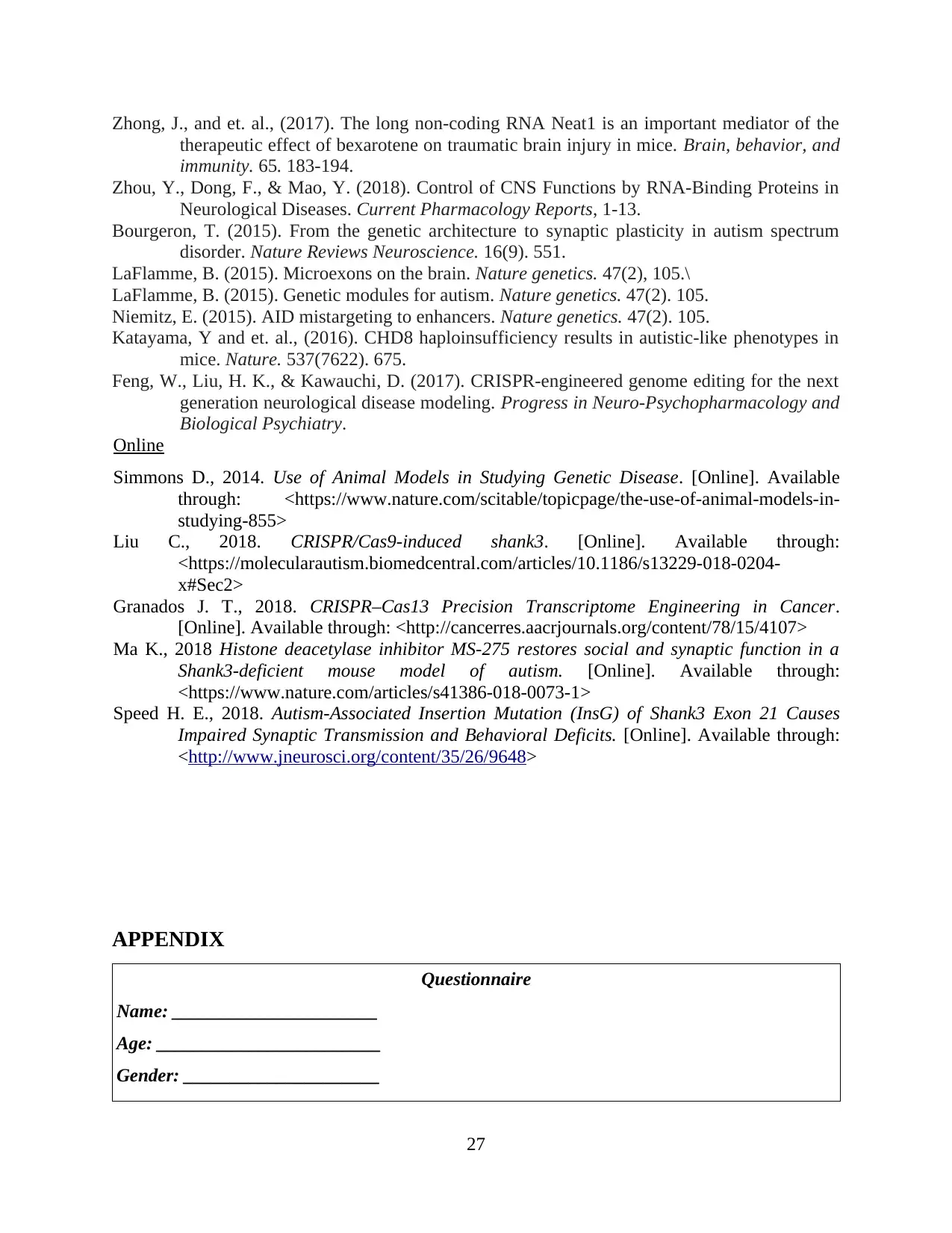
Zhong, J., and et. al., (2017). The long non-coding RNA Neat1 is an important mediator of the
therapeutic effect of bexarotene on traumatic brain injury in mice. Brain, behavior, and
immunity. 65. 183-194.
Zhou, Y., Dong, F., & Mao, Y. (2018). Control of CNS Functions by RNA-Binding Proteins in
Neurological Diseases. Current Pharmacology Reports, 1-13.
Bourgeron, T. (2015). From the genetic architecture to synaptic plasticity in autism spectrum
disorder. Nature Reviews Neuroscience. 16(9). 551.
LaFlamme, B. (2015). Microexons on the brain. Nature genetics. 47(2), 105.\
LaFlamme, B. (2015). Genetic modules for autism. Nature genetics. 47(2). 105.
Niemitz, E. (2015). AID mistargeting to enhancers. Nature genetics. 47(2). 105.
Katayama, Y and et. al., (2016). CHD8 haploinsufficiency results in autistic-like phenotypes in
mice. Nature. 537(7622). 675.
Feng, W., Liu, H. K., & Kawauchi, D. (2017). CRISPR-engineered genome editing for the next
generation neurological disease modeling. Progress in Neuro-Psychopharmacology and
Biological Psychiatry.
Online
Simmons D., 2014. Use of Animal Models in Studying Genetic Disease. [Online]. Available
through: <https://www.nature.com/scitable/topicpage/the-use-of-animal-models-in-
studying-855>
Liu C., 2018. CRISPR/Cas9-induced shank3. [Online]. Available through:
<https://molecularautism.biomedcentral.com/articles/10.1186/s13229-018-0204-
x#Sec2>
Granados J. T., 2018. CRISPR–Cas13 Precision Transcriptome Engineering in Cancer.
[Online]. Available through: <http://cancerres.aacrjournals.org/content/78/15/4107>
Ma K., 2018 Histone deacetylase inhibitor MS-275 restores social and synaptic function in a
Shank3-deficient mouse model of autism. [Online]. Available through:
<https://www.nature.com/articles/s41386-018-0073-1>
Speed H. E., 2018. Autism-Associated Insertion Mutation (InsG) of Shank3 Exon 21 Causes
Impaired Synaptic Transmission and Behavioral Deficits. [Online]. Available through:
<http://www.jneurosci.org/content/35/26/9648>
APPENDIX
Questionnaire
Name: ______________________
Age: ________________________
Gender: _____________________
27
therapeutic effect of bexarotene on traumatic brain injury in mice. Brain, behavior, and
immunity. 65. 183-194.
Zhou, Y., Dong, F., & Mao, Y. (2018). Control of CNS Functions by RNA-Binding Proteins in
Neurological Diseases. Current Pharmacology Reports, 1-13.
Bourgeron, T. (2015). From the genetic architecture to synaptic plasticity in autism spectrum
disorder. Nature Reviews Neuroscience. 16(9). 551.
LaFlamme, B. (2015). Microexons on the brain. Nature genetics. 47(2), 105.\
LaFlamme, B. (2015). Genetic modules for autism. Nature genetics. 47(2). 105.
Niemitz, E. (2015). AID mistargeting to enhancers. Nature genetics. 47(2). 105.
Katayama, Y and et. al., (2016). CHD8 haploinsufficiency results in autistic-like phenotypes in
mice. Nature. 537(7622). 675.
Feng, W., Liu, H. K., & Kawauchi, D. (2017). CRISPR-engineered genome editing for the next
generation neurological disease modeling. Progress in Neuro-Psychopharmacology and
Biological Psychiatry.
Online
Simmons D., 2014. Use of Animal Models in Studying Genetic Disease. [Online]. Available
through: <https://www.nature.com/scitable/topicpage/the-use-of-animal-models-in-
studying-855>
Liu C., 2018. CRISPR/Cas9-induced shank3. [Online]. Available through:
<https://molecularautism.biomedcentral.com/articles/10.1186/s13229-018-0204-
x#Sec2>
Granados J. T., 2018. CRISPR–Cas13 Precision Transcriptome Engineering in Cancer.
[Online]. Available through: <http://cancerres.aacrjournals.org/content/78/15/4107>
Ma K., 2018 Histone deacetylase inhibitor MS-275 restores social and synaptic function in a
Shank3-deficient mouse model of autism. [Online]. Available through:
<https://www.nature.com/articles/s41386-018-0073-1>
Speed H. E., 2018. Autism-Associated Insertion Mutation (InsG) of Shank3 Exon 21 Causes
Impaired Synaptic Transmission and Behavioral Deficits. [Online]. Available through:
<http://www.jneurosci.org/content/35/26/9648>
APPENDIX
Questionnaire
Name: ______________________
Age: ________________________
Gender: _____________________
27
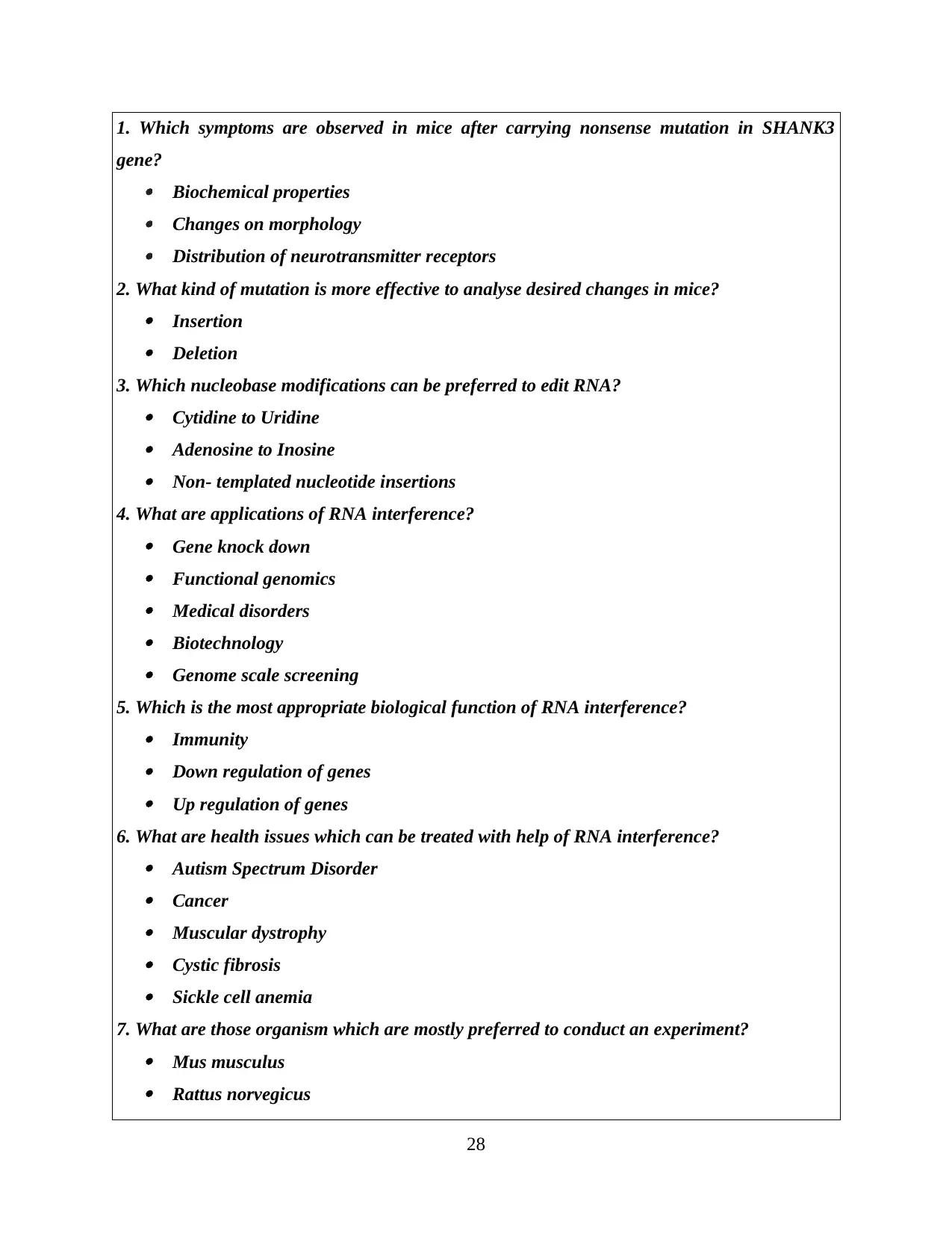
1. Which symptoms are observed in mice after carrying nonsense mutation in SHANK3
gene? Biochemical properties Changes on morphology Distribution of neurotransmitter receptors
2. What kind of mutation is more effective to analyse desired changes in mice? Insertion Deletion
3. Which nucleobase modifications can be preferred to edit RNA? Cytidine to Uridine Adenosine to Inosine Non- templated nucleotide insertions
4. What are applications of RNA interference? Gene knock down Functional genomics Medical disorders Biotechnology Genome scale screening
5. Which is the most appropriate biological function of RNA interference? Immunity Down regulation of genes Up regulation of genes
6. What are health issues which can be treated with help of RNA interference? Autism Spectrum Disorder Cancer Muscular dystrophy Cystic fibrosis Sickle cell anemia
7. What are those organism which are mostly preferred to conduct an experiment? Mus musculus Rattus norvegicus
28
gene? Biochemical properties Changes on morphology Distribution of neurotransmitter receptors
2. What kind of mutation is more effective to analyse desired changes in mice? Insertion Deletion
3. Which nucleobase modifications can be preferred to edit RNA? Cytidine to Uridine Adenosine to Inosine Non- templated nucleotide insertions
4. What are applications of RNA interference? Gene knock down Functional genomics Medical disorders Biotechnology Genome scale screening
5. Which is the most appropriate biological function of RNA interference? Immunity Down regulation of genes Up regulation of genes
6. What are health issues which can be treated with help of RNA interference? Autism Spectrum Disorder Cancer Muscular dystrophy Cystic fibrosis Sickle cell anemia
7. What are those organism which are mostly preferred to conduct an experiment? Mus musculus Rattus norvegicus
28
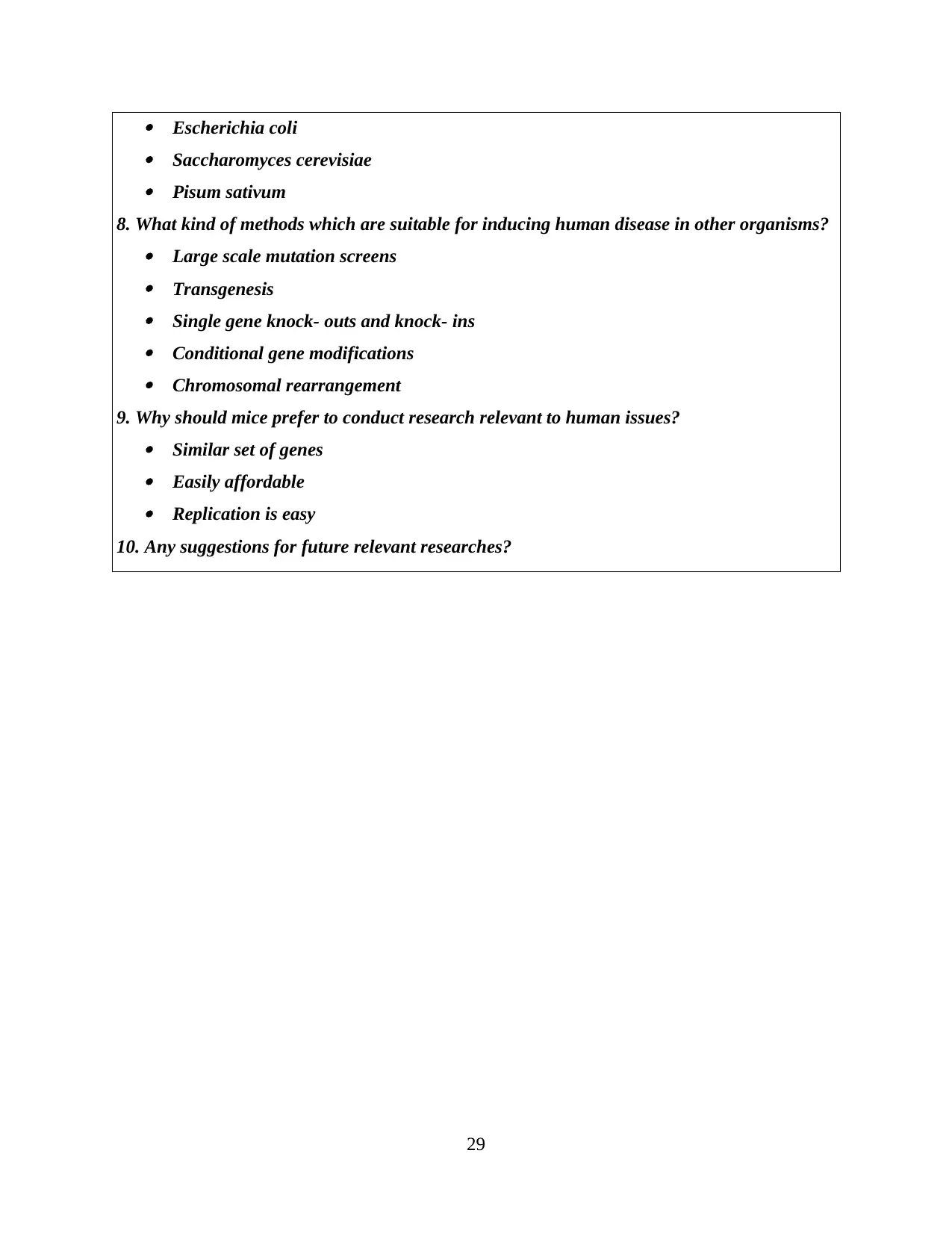
Escherichia coli Saccharomyces cerevisiae Pisum sativum
8. What kind of methods which are suitable for inducing human disease in other organisms? Large scale mutation screens Transgenesis Single gene knock- outs and knock- ins Conditional gene modifications Chromosomal rearrangement
9. Why should mice prefer to conduct research relevant to human issues? Similar set of genes Easily affordable Replication is easy
10. Any suggestions for future relevant researches?
29
8. What kind of methods which are suitable for inducing human disease in other organisms? Large scale mutation screens Transgenesis Single gene knock- outs and knock- ins Conditional gene modifications Chromosomal rearrangement
9. Why should mice prefer to conduct research relevant to human issues? Similar set of genes Easily affordable Replication is easy
10. Any suggestions for future relevant researches?
29
1 out of 31
Your All-in-One AI-Powered Toolkit for Academic Success.
+13062052269
info@desklib.com
Available 24*7 on WhatsApp / Email
![[object Object]](/_next/static/media/star-bottom.7253800d.svg)
Unlock your academic potential
© 2024 | Zucol Services PVT LTD | All rights reserved.

